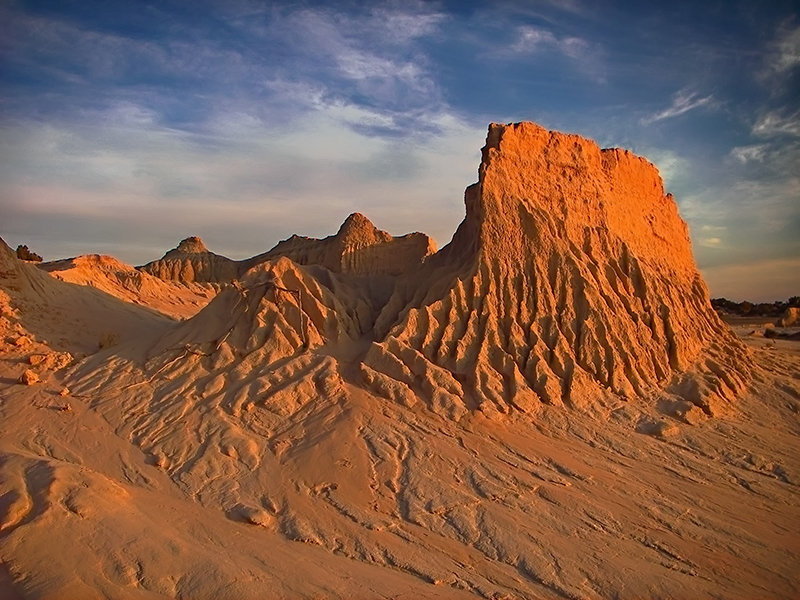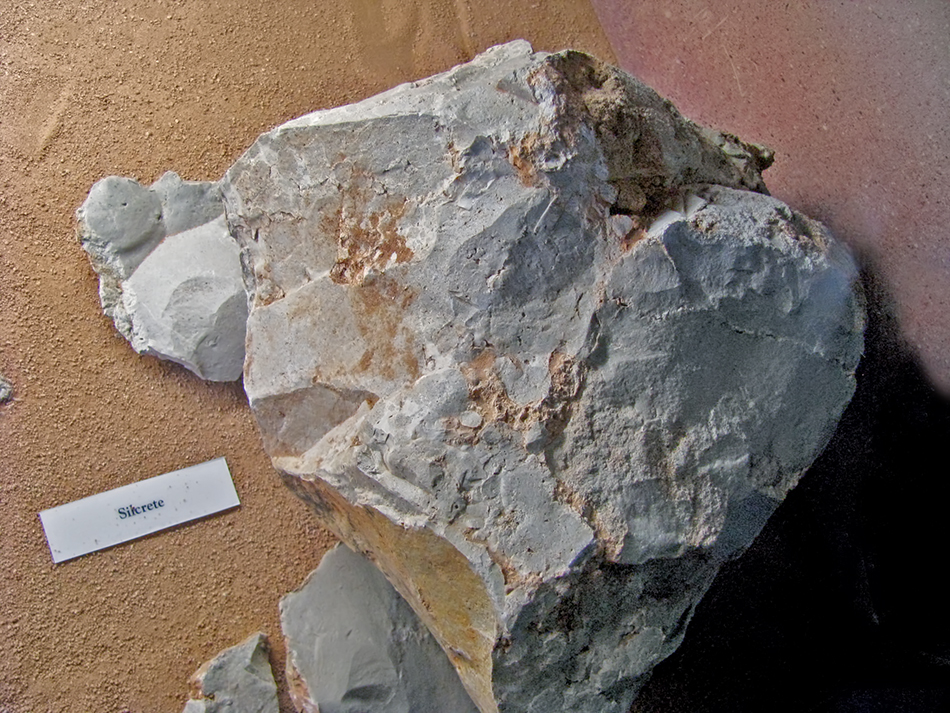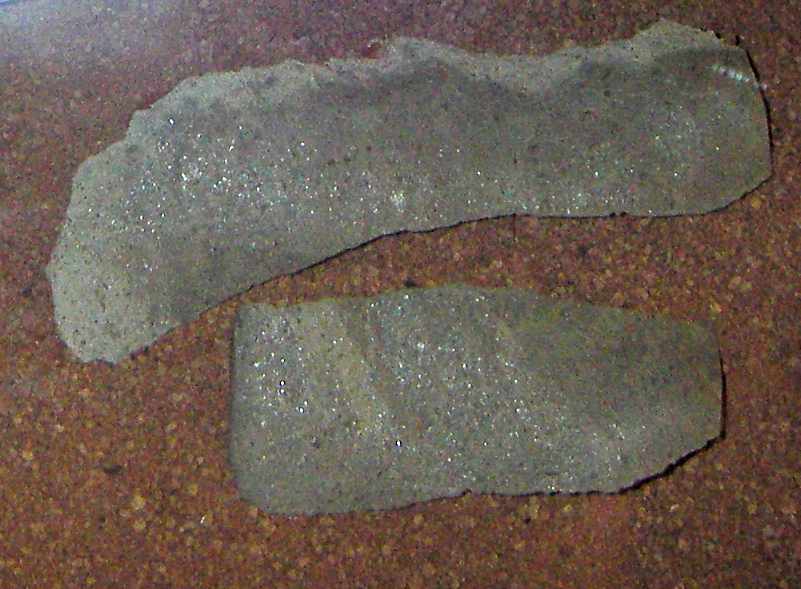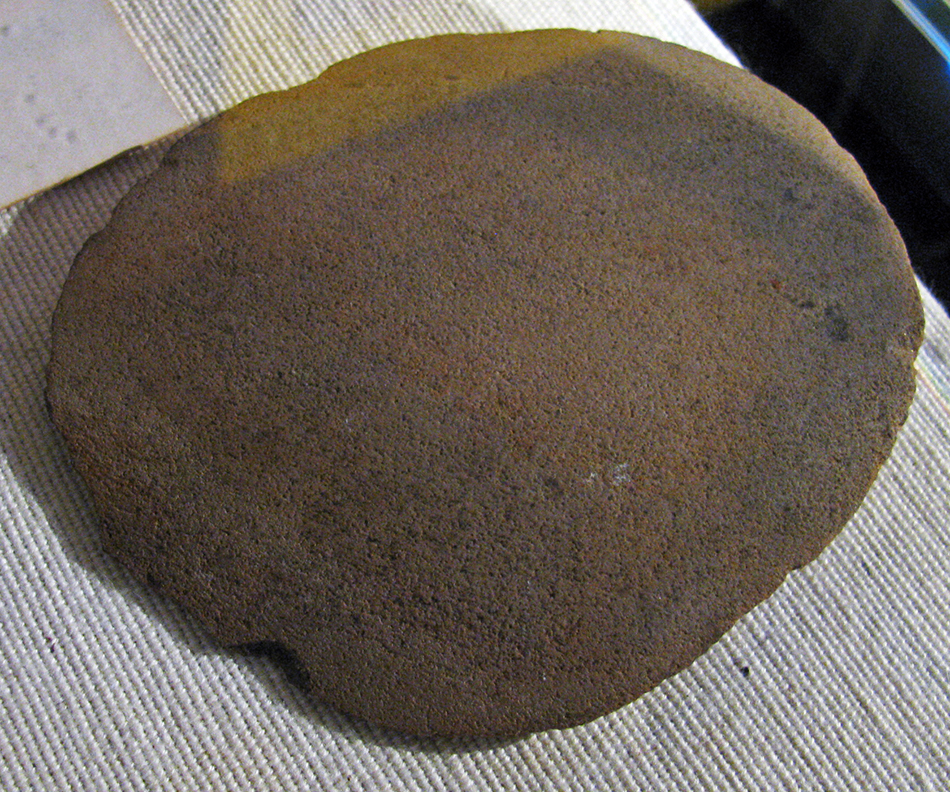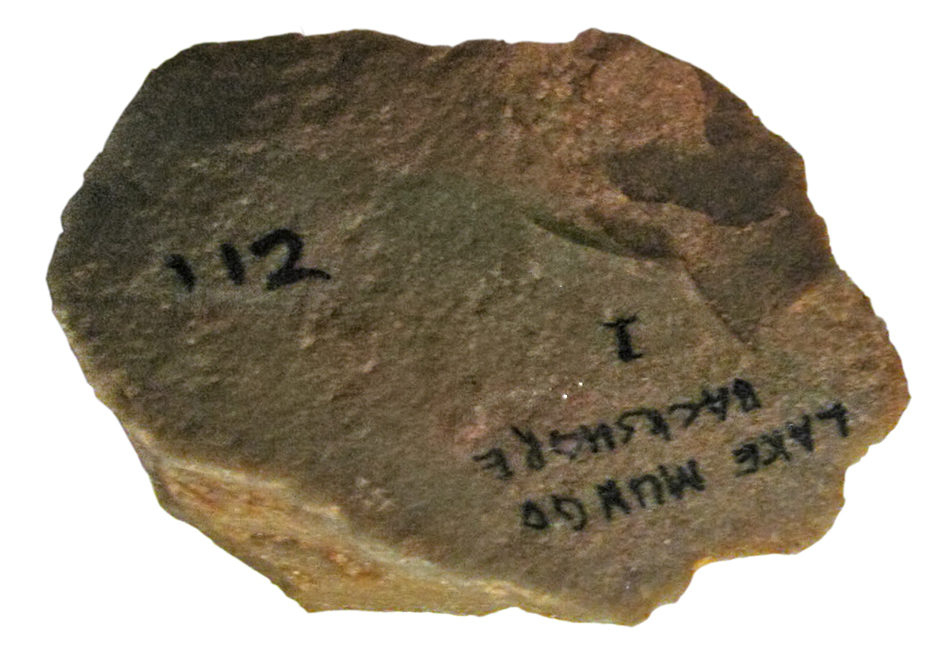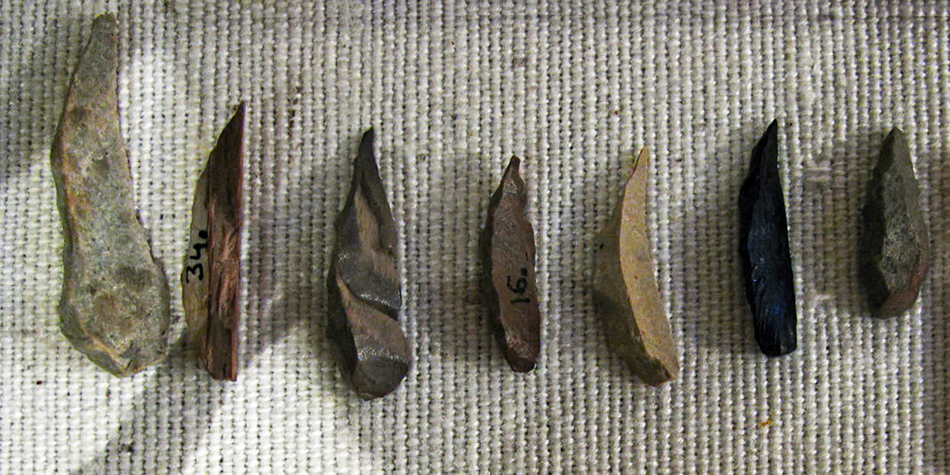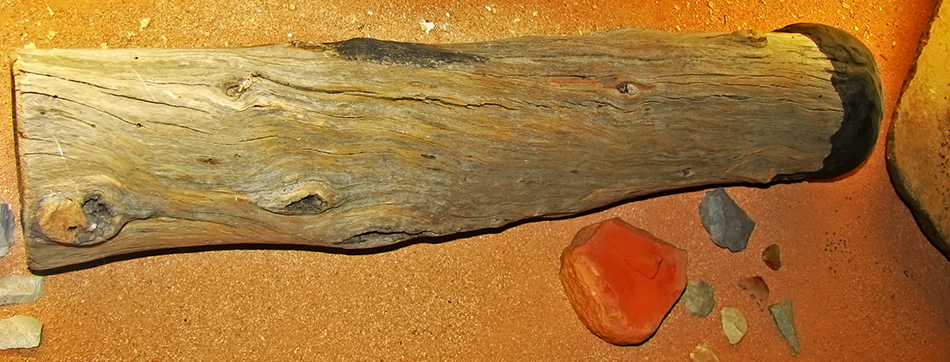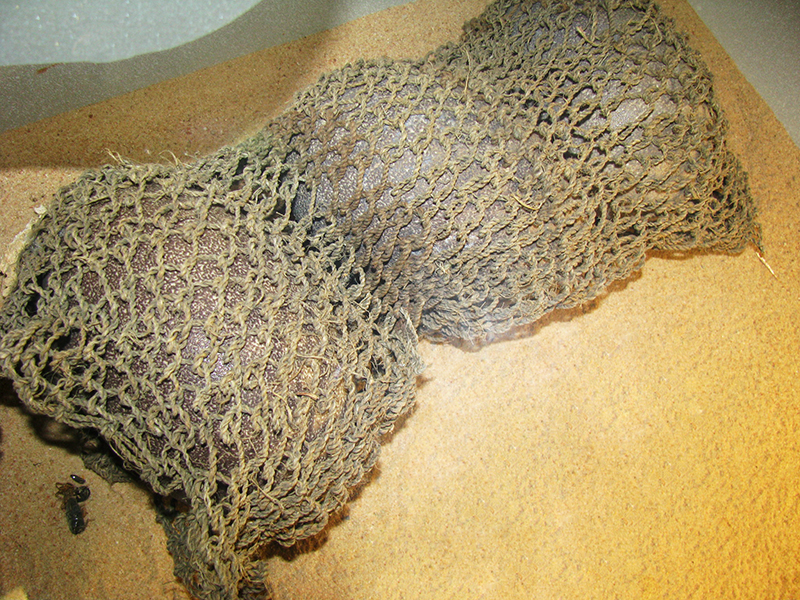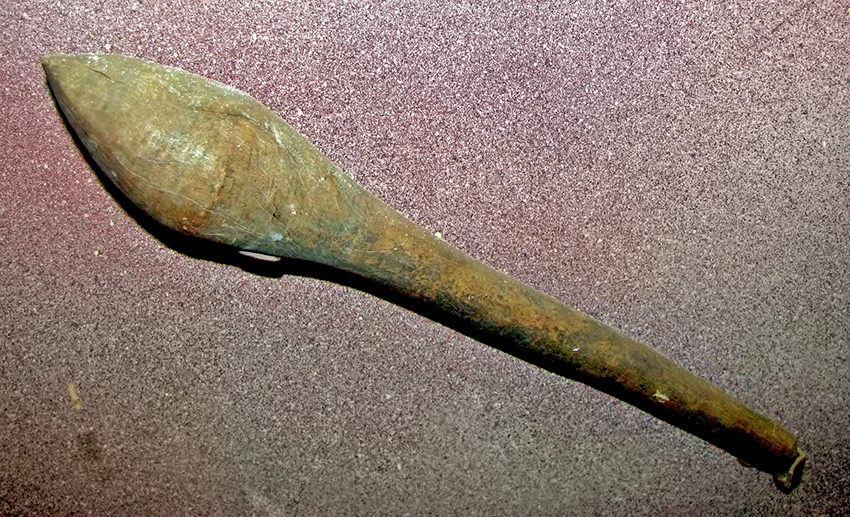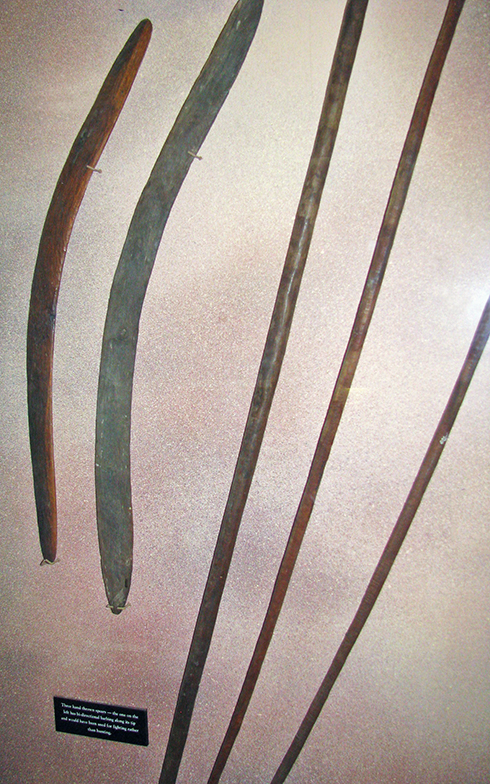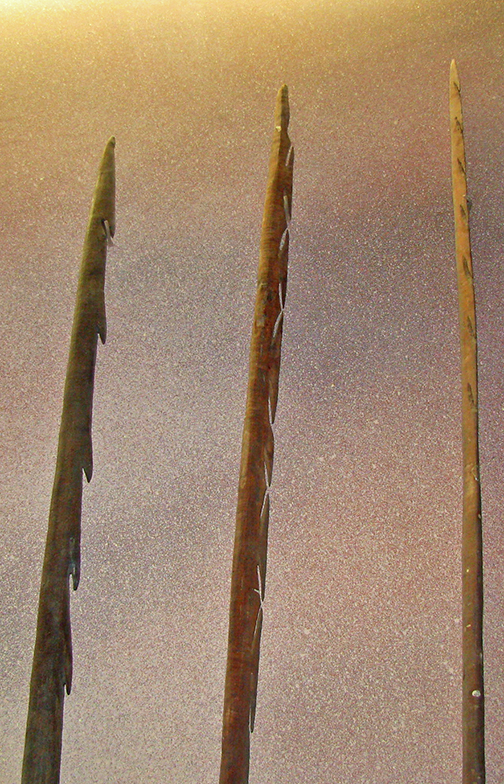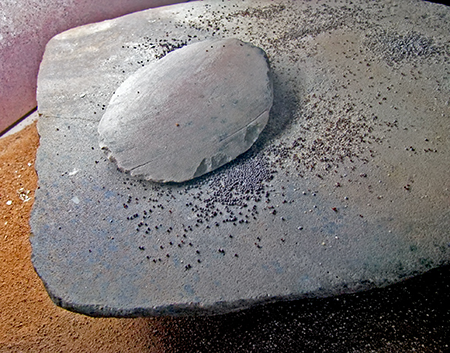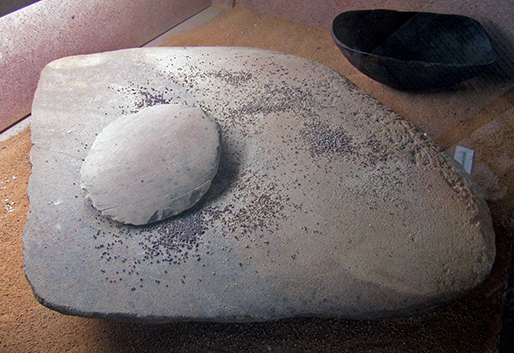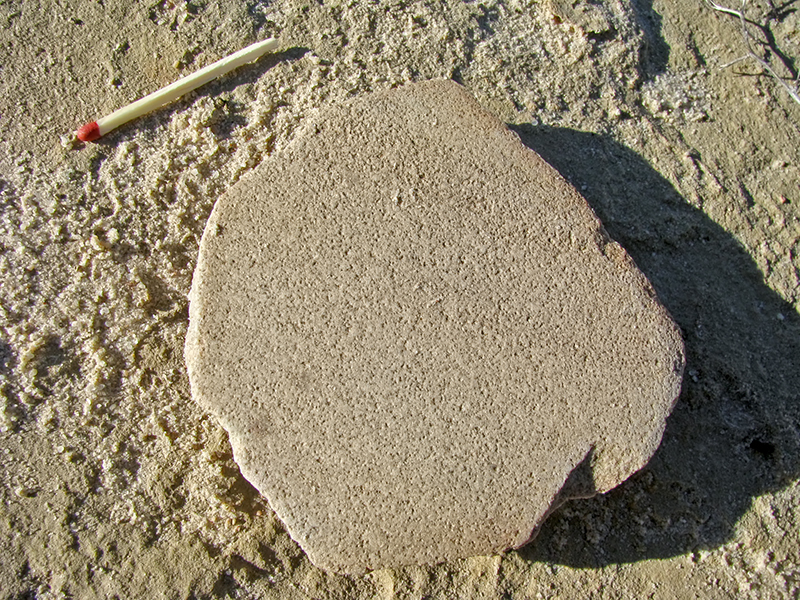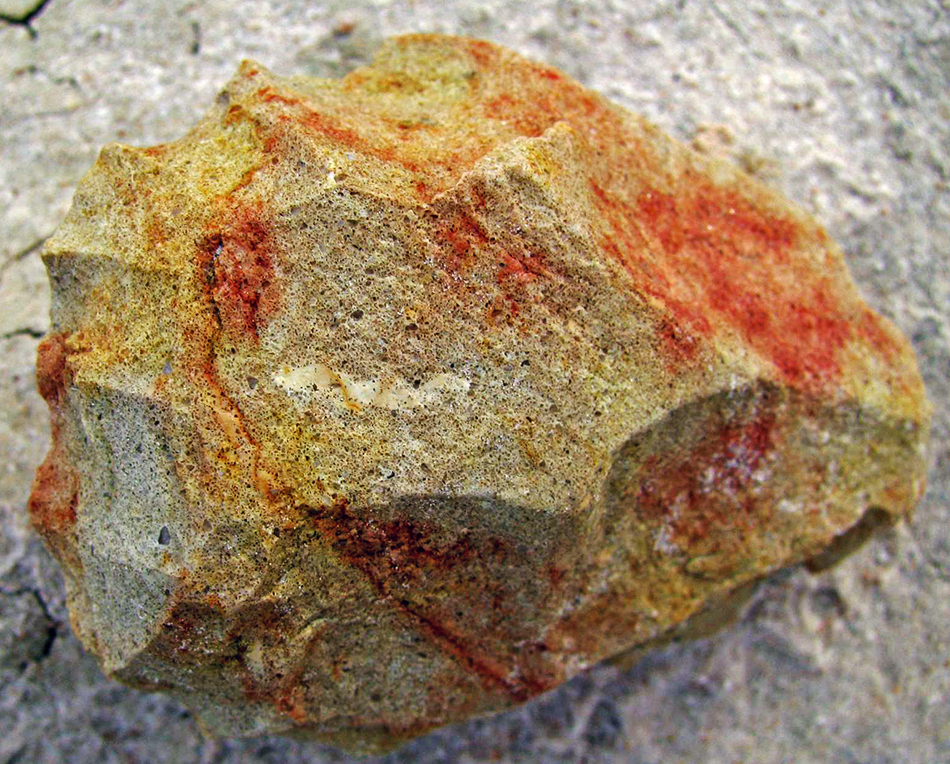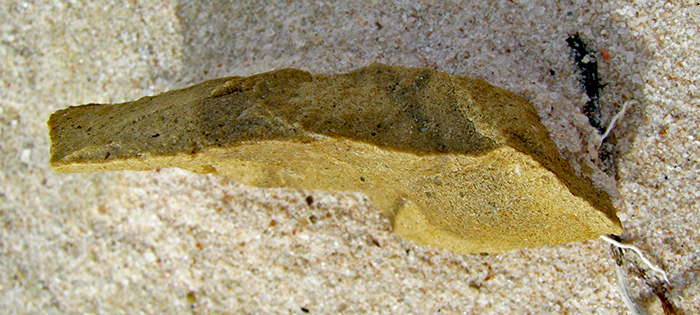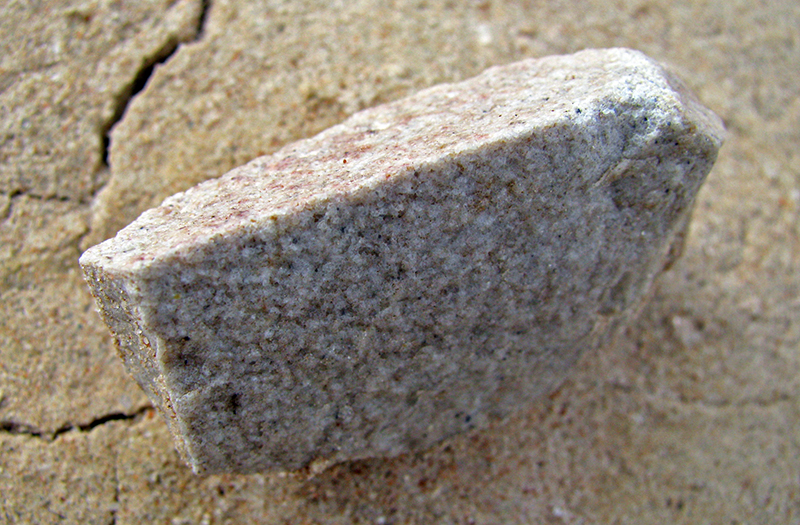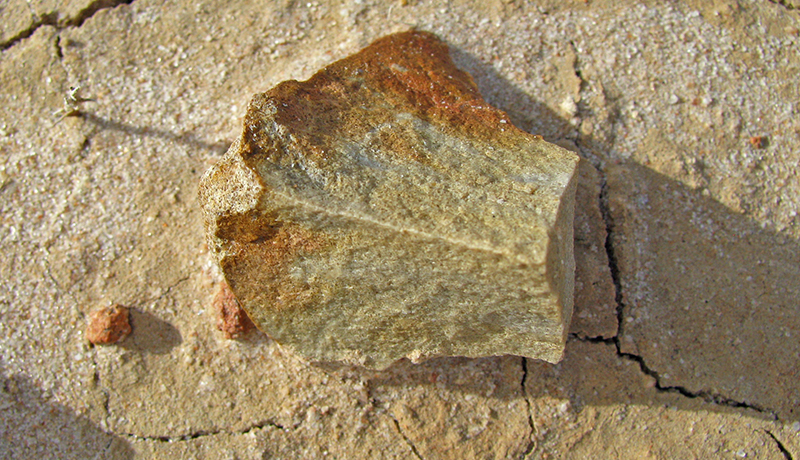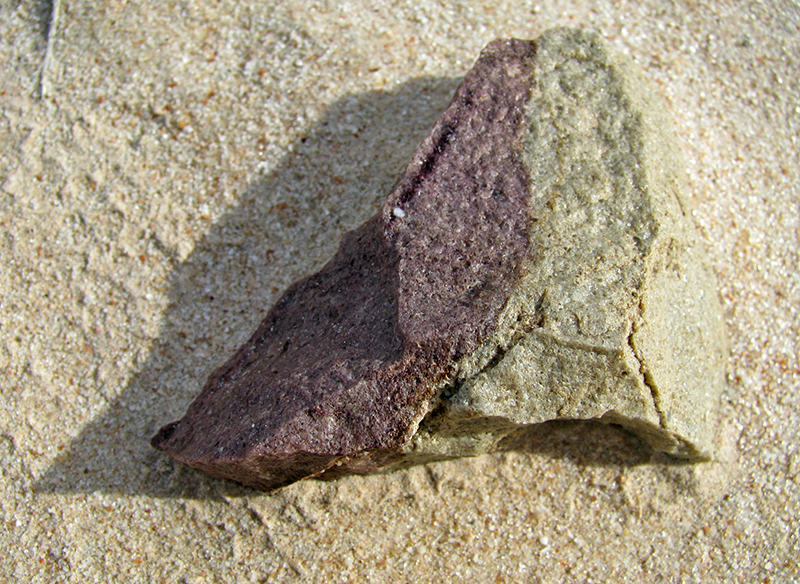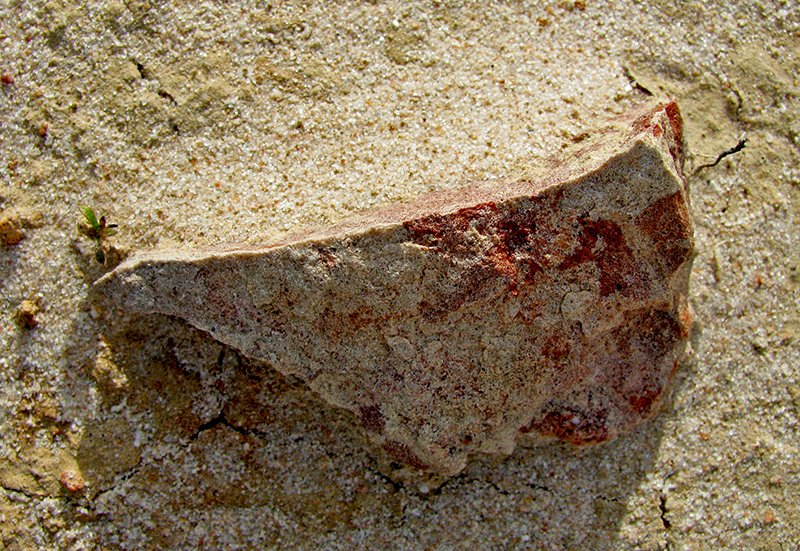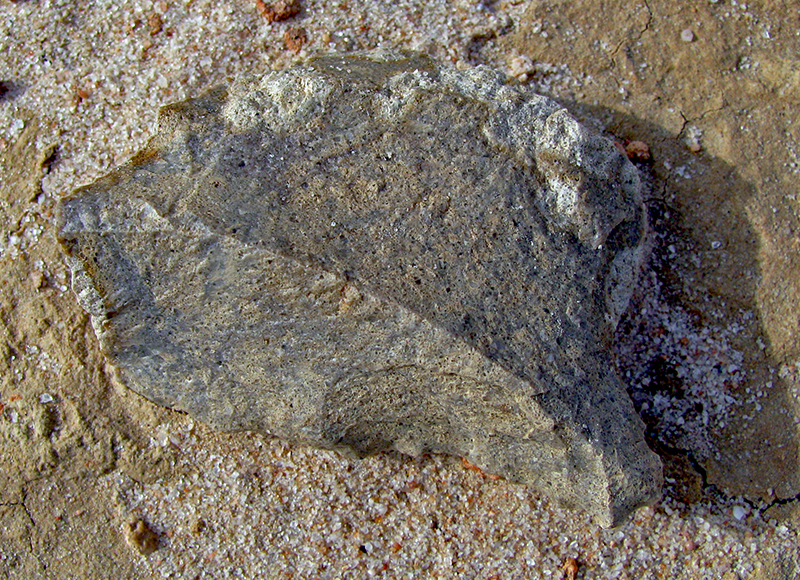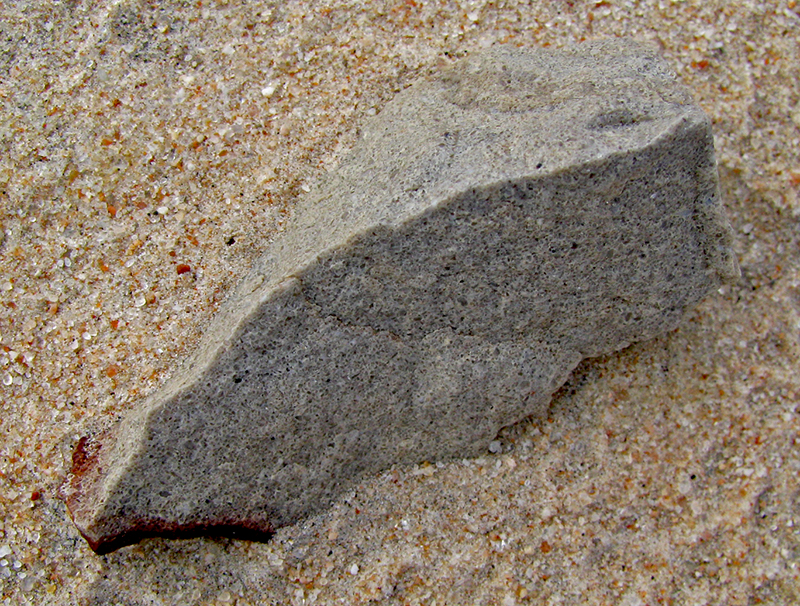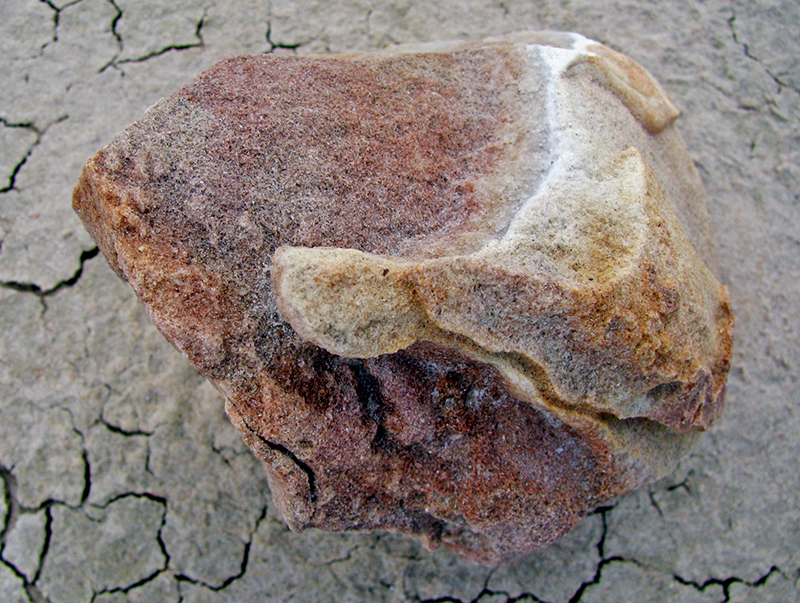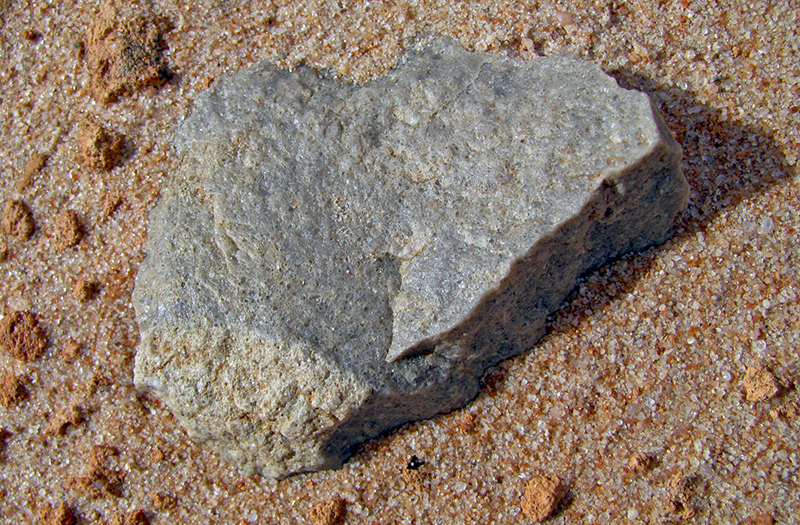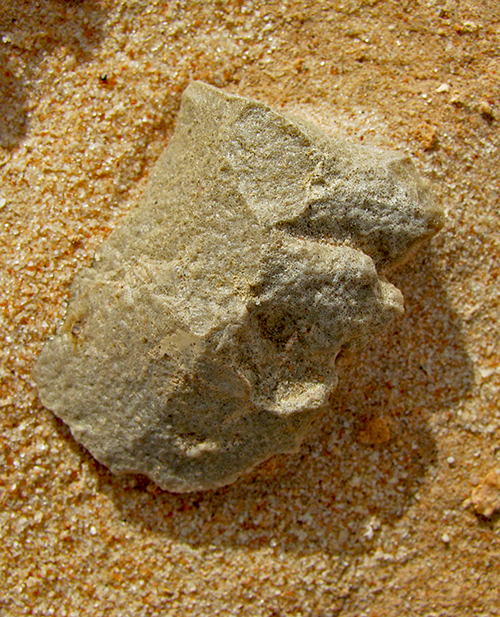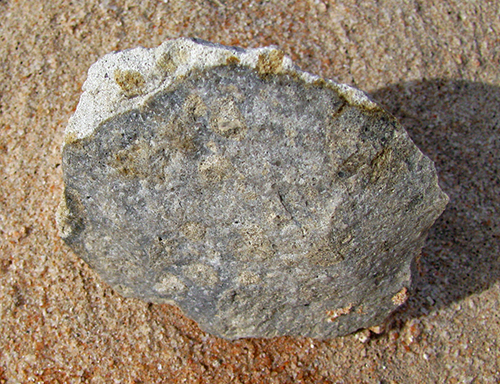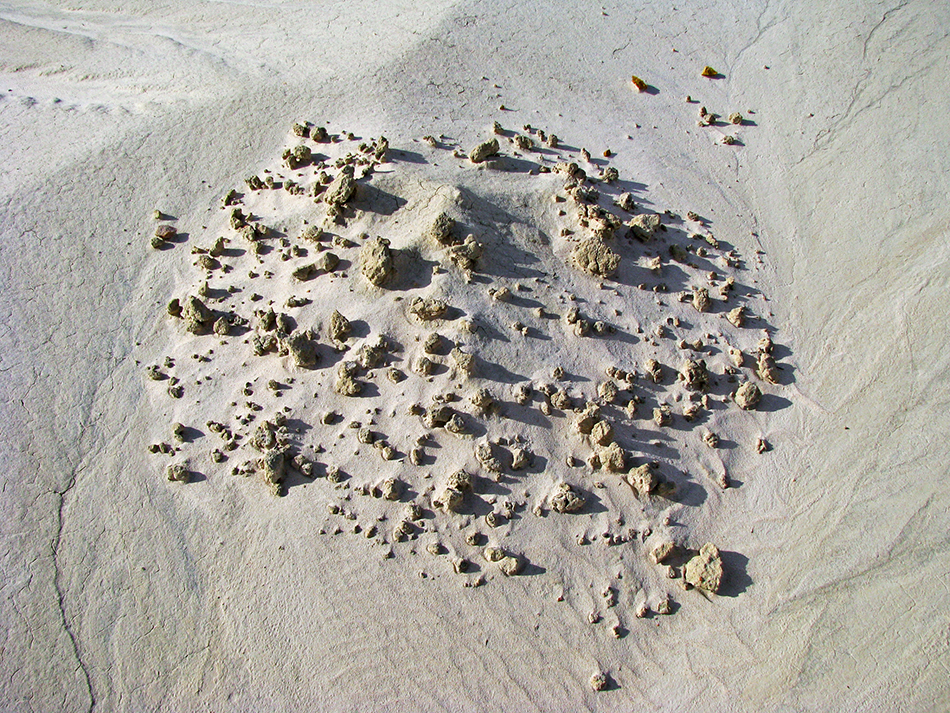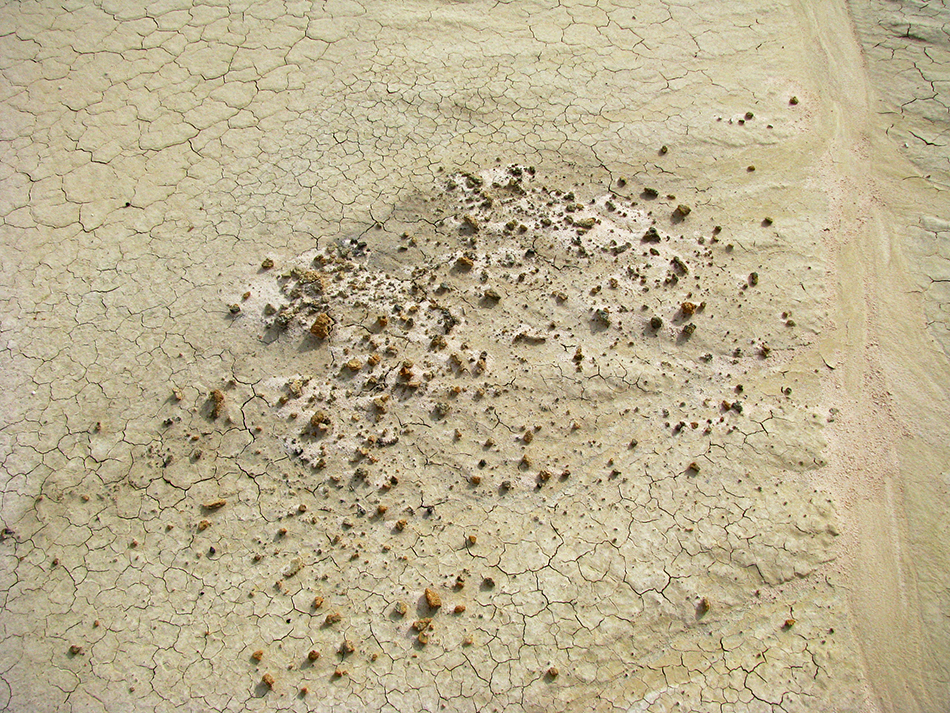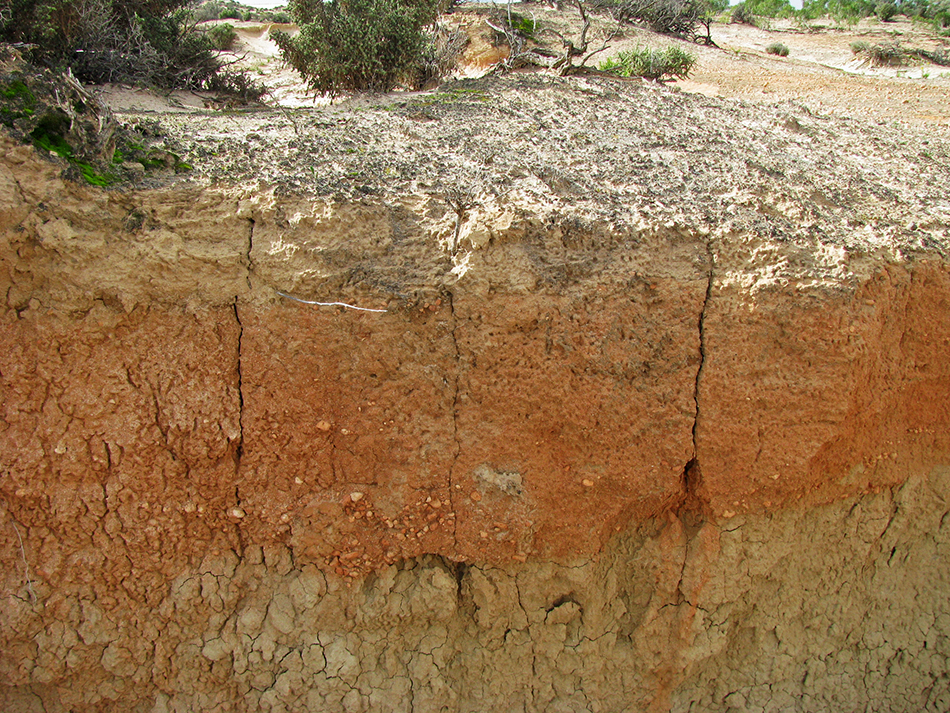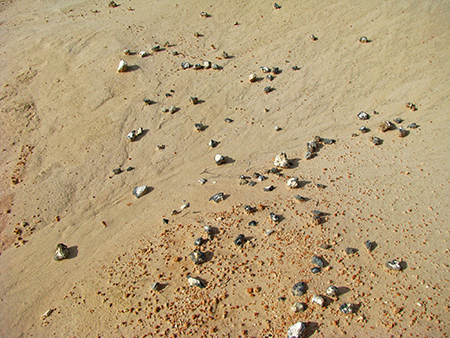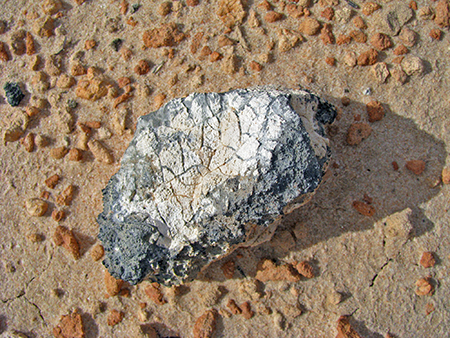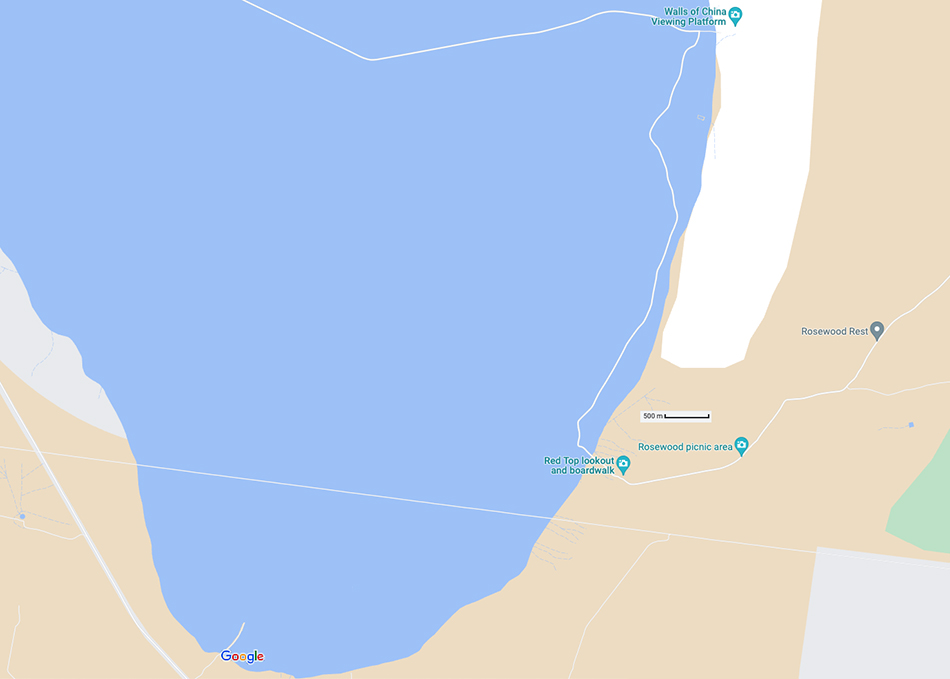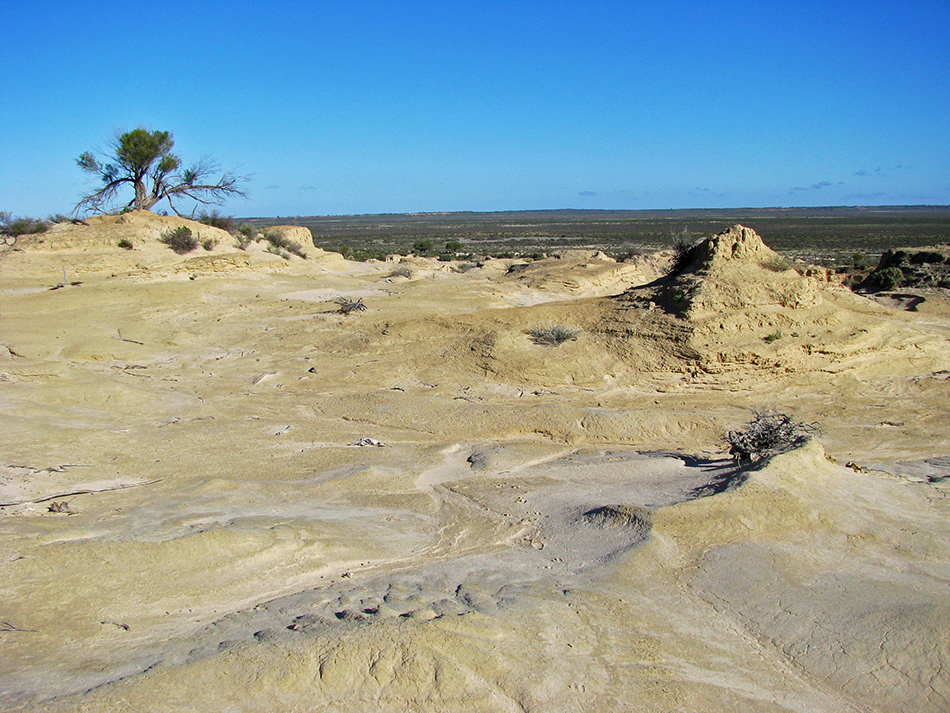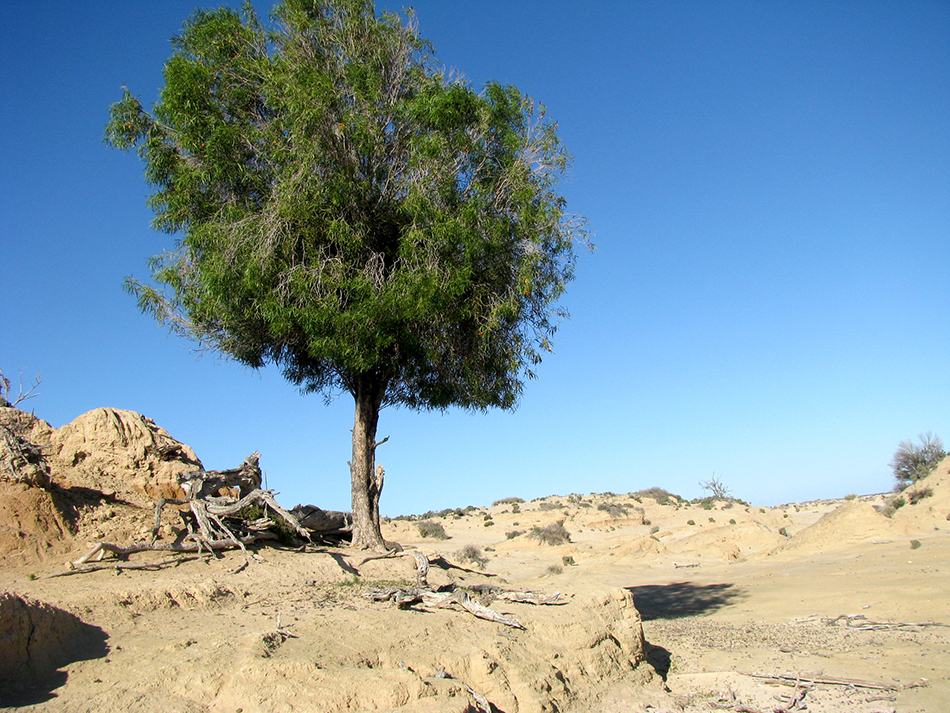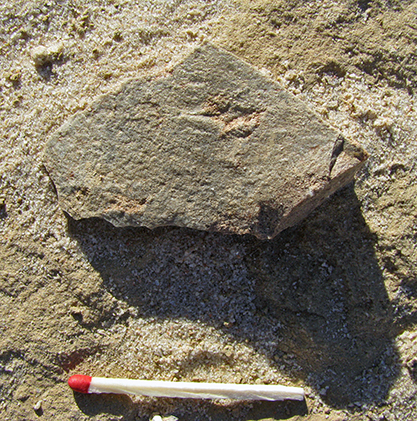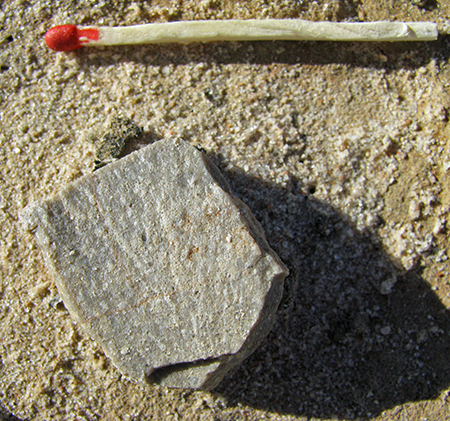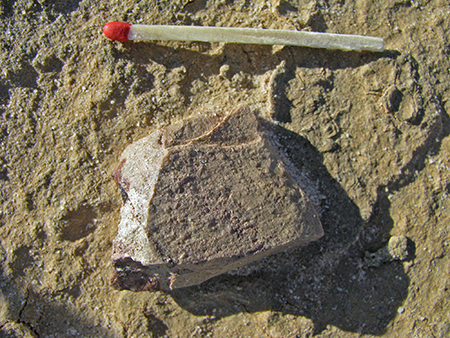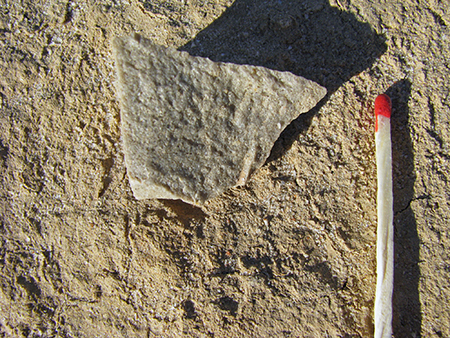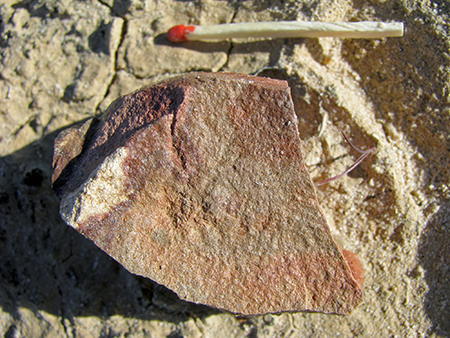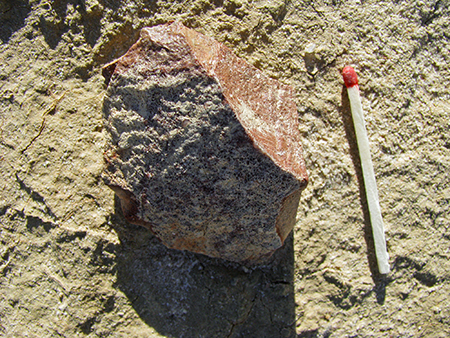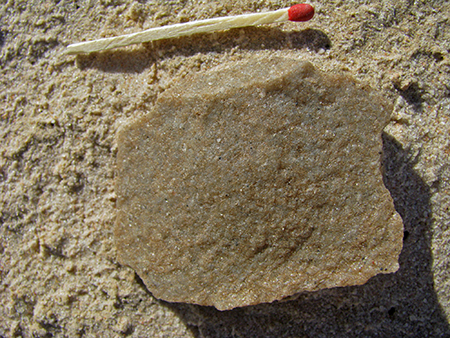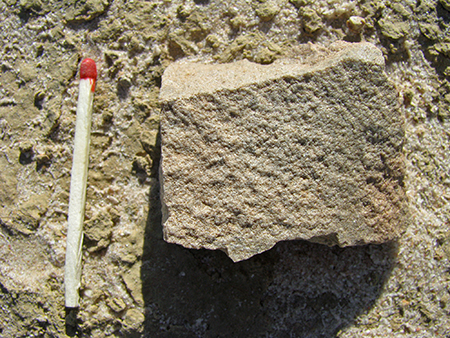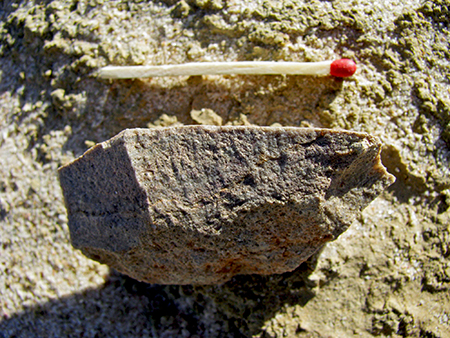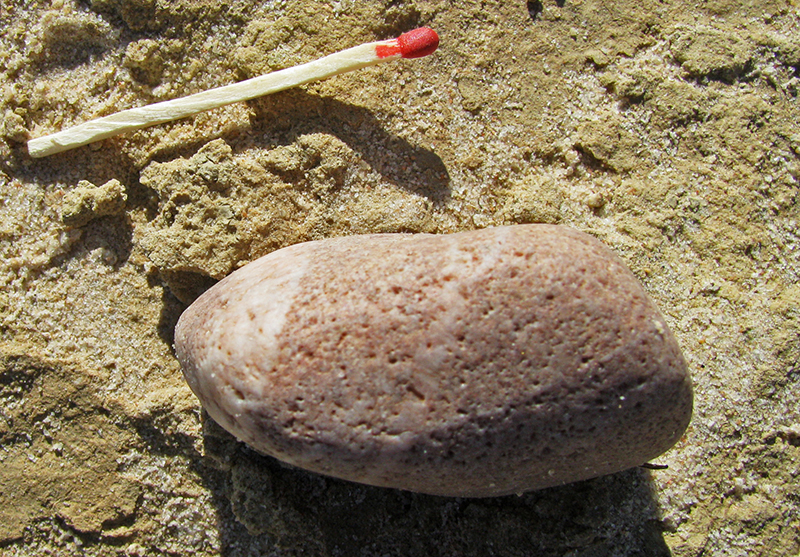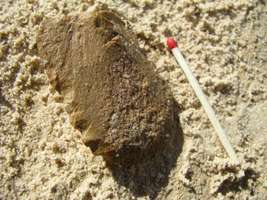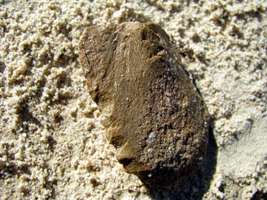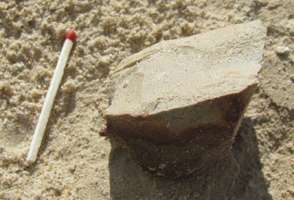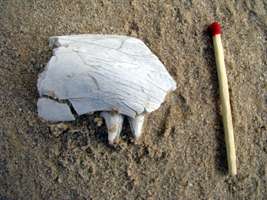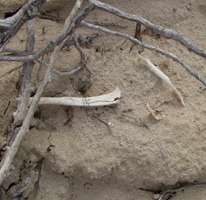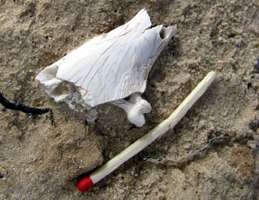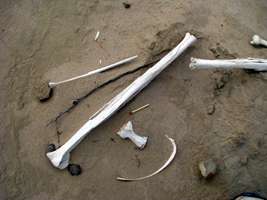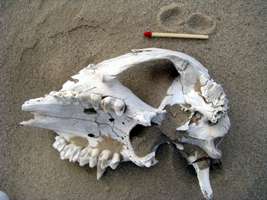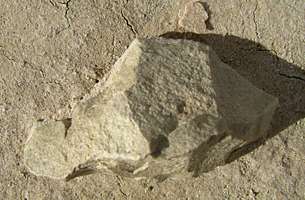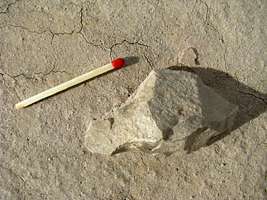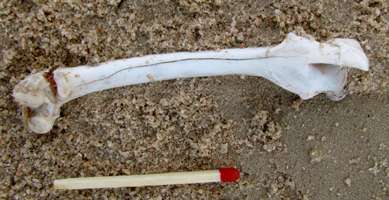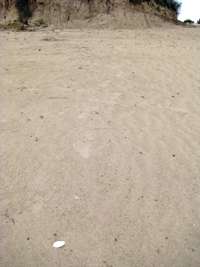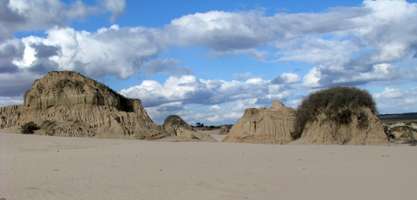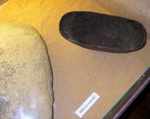Back to Don's Maps
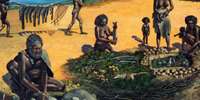 Back to Lake Mungo index
Back to Lake Mungo indexTools, Shells and Bones from Lake Mungo in Australia
The raw material for most of the Lake Mungo toolkit is silcrete. Silcretes are very hard layers of silica-enriched materials formed beneath the surface in soils, unconsolidated sediments, and permeable rocks.
The tools, shells and bones shown here are possibly 40 000 years old.
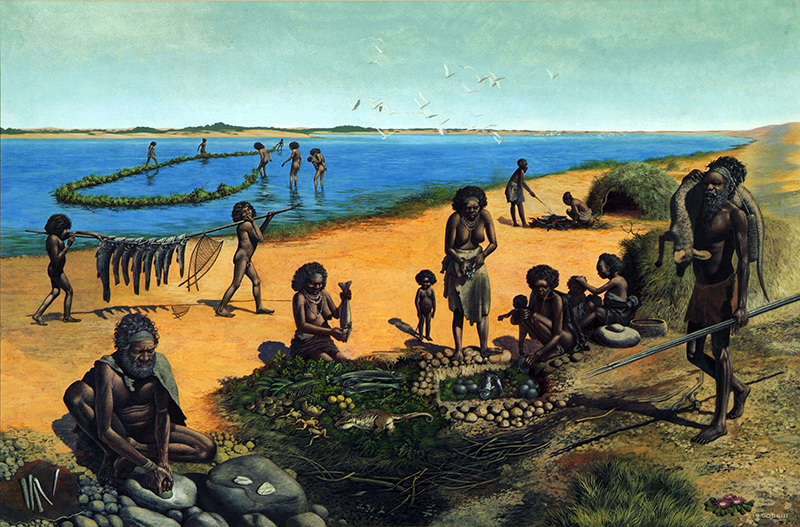
Painting of life at Lake Mungo by Giovanni Caselli. Note the fish traps, the wide variety of food hunted and collected, and the gunyahs or dwellings.
The ancestral First Nations tribes of the Mungo Lakes system are the Paakantyi to the west of the lakes, Mutthi Mutthi to the south, and the Ngiyaampaa to the north. Another tribal group, the Yita Yita, also once lived to the east of the lakes. Many Mutthi Mutthi people have Yita Yita ancestry.
Photo and artwork: Giovanni Caselli, by permission.
More than one way to catch a fish
Lake Mungo has the oldest record in the world for people cooking and eating freshwater fish. Until about 22 000 years ago the Willandra area contained a vast system of freshwater lakes where First Nations people lived - fishing for Golden Perch and Murray Cod and collecting freshwater mussels, yabbies,bird eggs, animals and bush tucker.Information on how First Nations people fished has been handed down through traditional kknowledge to contemporary First Nations people. European explorers also observed traditional fishing methods of the people who lived near the Murray and Darling Rivers.
Over thousands of years First Nations people developed efficient ways of catching fish. Below are examples of fishing methods used throughout the Australian continent.
Drugged - crushed toxic leaves and seeds were thrown into the water. This produced a toxin which stunned the fish.
Trapped - young trees were used to create a weir in a creek leaving an opening for a net. Large stone fish-trap complexes were also used to dam up small streams.
Netted - plant fibres were woven into nets which could be staked out to catch passing fish.
Plucked - in times of low water levels fish would become trapped in shallow isolated pools.These fish could be easily speared or simply plucked out of the water.
Hooked - line fishing existed in some areas of Australia using fish hooks made from shell.
Gathered - while some of the people were off hunting others collected mussels and yabbies.
(Source for text above: notice board at Lake Mungo)
Tools of the trade
As the interior of Australia gradually dried up between 30 000 - 20 0000 years ago, the people of Mungo had to increasingly depend on hunting methods other than fishing to survive. They had already developed a variety of stone and wooden tools - examples of which are displayed here. Fire was also to become one of the First Nations people's most useful hunting and gathering methods.
Along the western edge of the lake, silcrete ridges provided the raw material for stone tool production. Silcrete was an important source of stone in an area where few rocky outcrops existed. This stone material was quarried from its source then taken to campsites and made into a variety of multi-functional tools. The remains of some of these 'workshops' can still be seen around Mungo today.
As well as locally obtained material, stone of high quality had been traded into the Willandra region. Many imported stone implements such as axe heads crafted from green stone from Victoria have been found throughout the lakes area. Large slabs of sandstone were also carried into the area to be used for the important task of grinding and processing plant foodstuffs.
Razor sharp stone flakes and tools were useful for many day to day activites including cutting, scraping, and shaping with other wooden tools. Stone and wood were not the only form of tool technology used - fire held many uses for First Nations people. It was used for warmth, light, cooking, tool making, communicating and flushing out animals. Its use as a hunting strategy during 'burn offs' promoted new growth - enticing a flurry of wildlife activity.
The remains of tool making activities represent the main material left by the early cultures that once thrived there. Many other items of the past have not survived the thousands of years that separate us today.The durability of stone artefacts has ensured that a record of the past has remained. They have provided clues to understanding other aspects of an ancient culture.
Photo: Don Hitchcock 2005
Text: Display at Lake Mungo NPWS interpretation centre
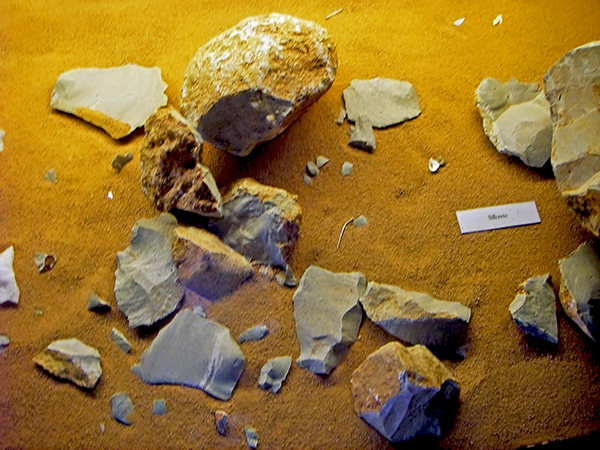
The raw material for most of the Lake Mungo toolkit is silcrete.
Silcretes are very hard layers of silica-enriched materials formed beneath the surface in soils, unconsolidated sediments, and permeable rocks. These materials range from silica-cemented sand and gravel to an amorphous matrix enriched with small silica particles. There is little agreement as to their classification and origin. A minimum silica (SiO2) content of 85 percent by weight has been proposed by Summerfield (1983) to distinguish silcretes from other duricrusts.
Although not restricted to arid regions, silcrete zones are found in many deserts, and they are most extensive and prominent topographic features in Australian deserts. Silcrete tends to form roughly horizontal, highly resistant layers generally less than 5 m thick. When exposed by erosion, silcrete forms highly resistant cap rocks of scarps ('breakaways' in Australia). These cap rocks resemble quartzite.
Many talus slopes and gravel plains in areas of exposed silcrete consist of silcrete fragments eroded from the cap rock. Buried silcrete layers thicker than 3 m are rare, and they are generally not laterally continuous over large areas.
Display: Lake Mungo NPWS interpretation centre
Text: The US Army Corps of Engineers Topographic Engineering Centre, at
http://www.tec.army.mil/research/products/desert_guide/lsmsheet/lssilc.htm
Photo: Don Hitchcock 2005
How is silica dissolved?
Lenher & Merril (1917) observe that while we commonly regard silica as one of our most insoluble substances, yet it has long been recognised that silica, even in the form of quartz, is somewhat soluble in water and in dilute acids.
Morey et al. (1962) write that saturated silica solutions in equilibrium with quartz were obtained in a few days at temperatures above 100°C. Equilibrium is shown by reproducible results for runs of different durations and by the precipitation of quartz from initially supersaturated solutions.
( Note, however, that most sources state that silcretes result from low-temperature surface or near-surface silicification - Don )
However, direct solution from quartz grains is not the only pathway to the solution of silica, as Dixon (2022) writes:
Silcrete formation involves three elements: a silica source, silica transport, and silica deposition. Silica sources include weathering of quartz and aluminosilicate minerals by solution and dissolution. Silica may also be derived from eolian ( wind action - Don ) addition, and from organic silica such as from grasses.
This is a superb source of silcrete for tools. Most are in the form of pebbles, not large, good quality blocks like this. There are examples which have been found at Mungo of jade axes brought in from Victoria because of the lack of appropriate size and quality stone at Mungo.
Photo: Don Hitchcock 2009
Source: Display at Lake Mungo NPWS interpretation centre
Text below from the display at the Lake Mungo Visitors centre:
A drying experience
Local studies of the Mungo geomorphology, (the development of landforms) have provided an interesting insight into the creation of the Mungo landscape. Over the last 50 000 years the Willandra Lakes landscape has been moulded by the powerful forces of the Ice Age. The coming and going of very cold climate conditions brought about a number of changes.The water levels in the Willandra Lakes were influenced by the changing climate. At times the lakes were full, then low, sometimes fresh, sometimes salty, then finally dry. During this entire period the First Nations people were present in the landscape - a remarkable indication of a highly adaptive lifestyle.
Pre 50 000 years ago
The climate was slightly colder than today. Snow and ice lay in basins on the Great Dividing Range. Lake Mungo was rimmed on the east by an old lunette made of deep red soil. This is known as the Gol Gol Unit. Vegetation covered the dry lake floor and dunes.50 000 - 30 000 years ago
A colder climate produced a large cover of snow and ice on the mountains. The Willandra Creek flowed freely, filling the lakes to overflowing. At Lake Mungo white quartz sand from the eastern beach was blown onto the lunette forming the Mungo Unit. Throughout this period climate conditions were stable enough to allow trees and shrubs to grow on the lunette.30 000 - 15 000 years ago
Snow and ice on the mountains built up as the climate became even colder. River and lake levels fluctuated. At times Lake Mungo was shallow and salty and small clay pellets formed on the exposed mud flats. Clay pellets and sand blew onto the lunette forming the Zanci Unit. Water erosion began to create deep gullies and wind blown sand formed large mobile dunes at the rear of the lunette. Salt tolerant plants established themselves on the lake floor.Quality of stone available at Lake Mungo for tools
These are long blades crafted from silcrete.
Although ( the local - Don ) silcrete is not an ideal material for blades, having too much granularity, the tools made by the Lake Mungo people are beautifully and elegantly made, with a minimum of blows in an apparently effortless style.
Source and text: Lake Mungo NPWS interpretation centre
Photo: Don Hitchcock 2005
Douglass J. et al. (2017) write concerning the lack of heavily retouched forms:
Silcrete flakes and cores are abundant in the surface assemblages from western New South Wales, Australia but retouched tools made from silcrete are much less frequent, especially the heavily retouched forms like flake adzes.Stern et al. (2013) write of the Lake Mungo stone artefacts (my emphases):
The chipped stone artefacts in these assemblages were made predominantly from silcrete, a silicified sandstone available from several locations within 20 km of the Mungo lunette. The grain size and quality of these silcretes varies considerably but can be grouped into coarse-grained and fine-grained varieties. Past studies have suggested that even the fine-grained silcrete is of low flaking quality, (Muhlen-Schulte (1985), Webb & Domanski (2008) )Stern et al. (2013) go on to say that:
Given the poor quality of silcrete in this region it is highly likely that quartzite was collected whenever it was encountered.M. H. Monroe at austhrutime.com/lake_mungo.htm describes research on the silcretes of Lake Mungo (my emphases):
The quarry is located on the western edge of the flat lake floor that is now dry, large silcrete blocks and boulders cover a low ridge, silcrete gravel occurring along the edge of the lake. Over the area of the quarry are stone axes, and nearly all the boulders show some signs of human activity (Allen (1990), Williams (1991)). On the western shores of Lake Chibnalwood and Lake Leaghur there are also silcrete exposures that have been quarried for stone artefacts. There are few stone sources in the area of the Willandra Lakes, the result being that the sources in the area of the quarries have attracted the ancestral First Nations groups to the quarries throughout their occupation of the area. (Allen (1998))Heat treatment of stone, commonly to 200 C or more, is thought to improve the stone's quality and workability. Schmidt & Hiscock (2020) write (my emphases):
In the Willandra Lakes region most of the raw material in archaeological sites is silcrete, together with much smaller amounts of quartzite and sandstone. Both types of silcrete found in the quarries were used to make artefacts, 95% of the artefacts were made from the medium-grained silcrete and the remainder from fine-grained silcrete (Allen (1998)).
The authors used samples from the quarries for their study reported in Source 2, most of the samples being of a dull yellow orange colour with a thin weathering rind that was grey, with relatively larger inclusions of clay-cemented material that are light grey on the uneven granular fracture surfaces.
The medium-grained Lake Mungo silcrete used for the manufacture of implements consists mostly of a matrix of microcrystalline quartz with quartz clasts that are well-sorted, and sub-angular to sub-round, and mostly medium-sand-sized, and it has a microfabric that is grain-supported (Fig. 2a & Table 1, Source 2).
The Lake Mungo medium-grained silcrete was shown by the mechanical tests of the authors (Table 2, Source 2) to have poor flaking properties, with a high fracture toughness that makes it difficult to knap, the fracture toughness being lowered greatly by the inclusions of clay-cemented material. Fracture propagation of Lake Mungo silcrete lacks directional stability because of a low index of stiffness, resulting in a high frequency of step fracture terminations that are also the result of the defects in microstructure, that are represented by the medium-sand-sized quartz grains. As a result of this the Lake Mungo silcrete is much less suitable for narrow flake detachment and resharpening of the working edges.
The authors suggest the Lake Mungo medium-grained silcrete was often used for the manufacture of steep-stepped flaked artefacts, such as horsehoof cores and steep-edged scrapers (White & O'Connell (1992), Cottrell & Kamminga (1987), Allen (1998)), as the mechanical properties have a less deleterious effect for large, wide flake detachment (Cottrell & Kamminga (1987), Hiscock (1983))
Blocky horsehoof cores and various forms of scraper are common in lithic assemblages from the Late Pleistocene and Holocene in the Willandra Lakes region (Jones & Allen, in Bowler et al. (1970), Allen (1998), Hiscock & Allen (2000))
The evolution of heat treatment for stone artefact production is a subject of major interest for our understanding of early modern humans. In this study, we examine the evidence from one region in Australia to provide a new record of the antiquity of heat treatment, explore chronological shifts in the frequency of heat treatment, and discuss the implications of these findings for early population dynamics and the technical knowledge early settlers might have brought with them. Until now, Australian heat treatment has only dated back 25000 years.
This study of the Willandra Lakes, including Lake Mungo, has identified the oldest systematic evidence of heat treatment yet reported in Australia, dating to ∼42000 years. We also document time-dependent directional change in the frequency of the practice. At those early times, with over 60% of all silcrete artefacts heat-treated, we hypothesize that the practice was mastered and integrated as a recurrent technical solution to the complexities of knapping silcrete.
Australia has some silcretes that are similar in working quality to flint.
M.H.Monroe writes, citing Webb & Domanski (2008):
At Olive Downs Quarry near Tibooburra, outcrops of pedogenic silcrete occur in a layer in low scarps in the Sturt National Park, western New South Wales, 25 km east of Tibooburra, that is laterally continuous (Watts, 1978), as well as extensive 'gibber' pavements of closely packed cobbles that are sub-spherical, the silcrete occurring as microcrystalline, medium-sized and fine-grained varieties (Table 1, Doelman et al. (2001)).
Conchoidal fracturing is present in the Olive Downs silcrete, of light brownish-grey to dull red colour, and it is microcrystalline, predominantly consisting of a microcrystalline quartz matrix with angular clasts of mostly silt-sized quartz that are scattered throughout the matrix. Also in the silcrete are occasional layers and patches of coarser quartz clasts, up to 2 mm in diameter (Fig. 2 (B) & Table 1, Source 1) and clay that is partially silicified, iron oxide minerals that are very fine-grained, as well as small cavities that are up to 1 mm in diameter.
The microcrystalline silcrete from Olive Downs has been found to have mechanical properties that are similar to those of Australian flint ( Doelman et al. (2001), table 1), in fracture toughness, compressive strength and index of stiffness, as well as in their petrology, in the form of very fine quartz crystals forming an interlocking matrix. According to the authors, the flaking quality of some samples is markedly decreased by the presence of soft clay, iron oxide and organic inclusions that lower to a significant degree the fracture toughness and compressive strength.
Below we can see the difference between the size of the clasts in a silcrete sample from Lake Mungo on the left, and a silcrete sample from Olive Downs on the right.
Nearly all of the Lake Mungo silcretes are of coarse silcrete, a very difficult material to knap, while at Olive Downs the silcrete is of similar quality to flint.
Thin-section micrographs of inland silcretes. (A) Lake Mungo (sample 196): well-sorted subangular to subrounded medium-sand-sized clasts in microcrystalline matrix. (B) Olive Downs (sample 358): microcrystalline matrix with scattered angular silt-sized clasts.
Photo and text: Webb & Domanski (2008)
Stone used in Australia for tools
Silcrete geometric microliths, used as part of a compound spearhead.
( The two microliths on the right appear to have been initially made by truncation of a thin, small blade, followed by careful and skilled retouching - Don )
Microliths are produced from either a small blade (microblade) or a larger blade-like piece of flint by abrupt or truncated retouching, which leaves a very typical piece of waste, called a microburin. The microliths themselves are sufficiently worked so as to be distinguishable from workshop waste or accidents.
Two families of microliths are usually defined: laminar and geometric. An assemblage of microliths can be used to date an archeological site. Laminar microliths are slightly larger, and are associated with the end of the Upper Palaeolithic and the beginning of the Epipalaeolithic era; geometric microliths are characteristic of the Mesolithic and the Neolithic. Geometric microliths may be triangular, trapezoid or lunate. Microlith production generally declined in Europe following the introduction of agriculture (10 000 BP) but continued later in cultures with a deeply rooted hunting tradition.
Regardless of type, microliths were used to form the points of hunting weapons, such as spears and (in later periods) arrows, and other artefacts and are found throughout Africa, Asia and Europe. They were utilised with wood, bone, resin and fiber to form a composite tool or weapon, and traces of wood to which microliths were attached have been found in Sweden, Denmark and England. An average of between six and eighteen microliths may often have been used in one spear or harpoon, but only one or two in an arrow. The shift from earlier larger tools had an advantage. Often the haft of a tool was harder to produce than the point or edge: replacing dull or broken microliths with new easily portable ones was easier than making new hafts or handles.
( It may also be noted that such spear heads caused much more laceration of the prey at the site of the wound, resulting in more 'shock' or bleeding, and a quick knock down - Don )
Collected at Arcoona, South Australia by F. D. Campbell, 1964.
Photo: Don Hitchcock 2010
Source and identification: Sydney Museum
Additional text: Wikipedia

This silcrete flake has been significantly retouched, and hafted with spinifex resin so that it may be more easily used as a knife.
Collected at Port Darwin, Northern Territory, by J. Brazier, 1918.
Source: Sydney Museum
Photo: Don Hitchcock 2010
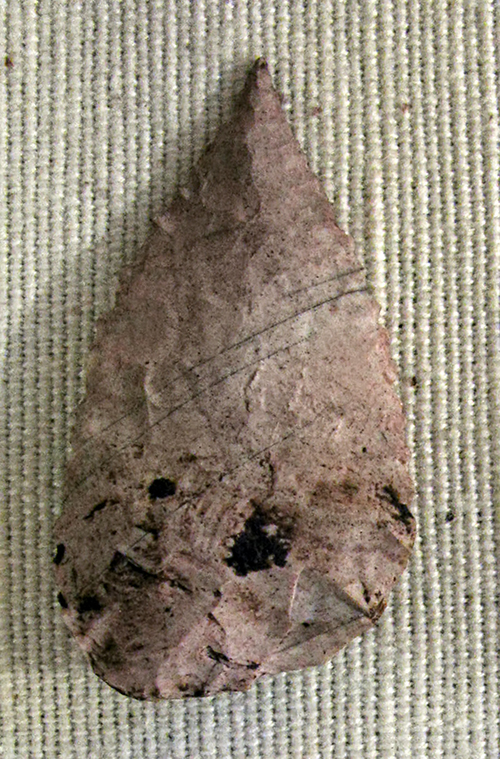
Chert bifacial point.
( This is a beautifully made piece. The upper two thirds appears to have been pressure flaked across its whole width. The discolouration and comparative lack of attention to shape and smoothness on the lower part may indicate that it was designed to be hafted with spinifex resin, as in the silcrete flake above, and was originally so used - Don )
Collected at Wave Hill, Northern Territory by W.D. Campbell, 1956.
Source: Sydney Museum
Photo: Don Hitchcock 2010

Quartzite straight-edged scraper.
Collected on the surface of the Walls of China, Lake Mungo, by H. Allen, 1969.
Source: Sydney Museum
Photo: Don Hitchcock 2010
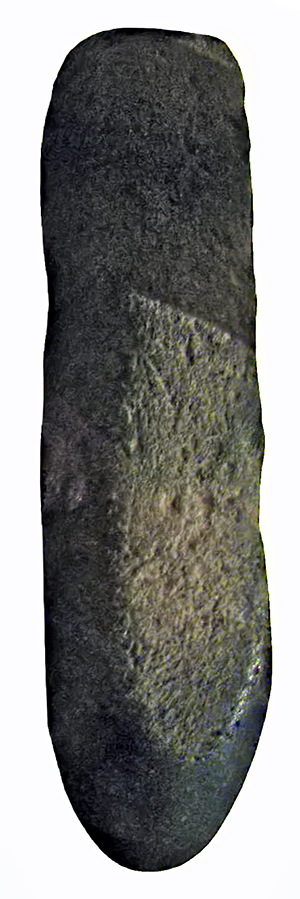
Edge-ground chisel.
Collected at Dungowan, Peel River, NSW, by an unknown collector, 1928.
Source: Sydney Museum
Photo: Don Hitchcock 2010
Sandstone upper grindstone.
Collected at Hay District, NSW, by A. Hyde-Page, 1937.
Source: Sydney Museum
Photo: Don Hitchcock 2010
Sandstone grindstone.
( Note that this lower grindstone has been carefully carved into a dish shape with a shallow 'spout' for pouring out the ground flour or other ground foodstuffs - Don )
Collected at Hay District, NSW, by A. Hyde-Page, 1937.
Source: Sydney Museum
Photo: Don Hitchcock 2010
Grinding stone.
Collected at Menindee, New South Wales by H. Langwell, 1931
Source: Sydney Museum
Photo: Don Hitchcock 2010
Edge-ground axe head
Collected at Fairfield, New South Wales, by R. Sawkins, 1958.
Source: Sydney Museum
Photo: Don Hitchcock 2010
Silcrete horsehoof core
Collected on the surface of the Lake Mungo backshore, New South Wales, by H. Allen, 1970-1971.
( The backshore is the often fairly flat and more extensive part of the beach lying between the steeper foreshore of the lake and the foot of the dunes - Don )
Professor Mark Moore of UNE Armidale, a distinguished scholar, ARC Future Fellow, Director, Stone Tools and Cognition Hub - School of Humanities, Arts, and Social Sciences, writes in stonetoolsmuseum.com, a superb and well researched website, the following about horsehoof cores:
Horsehoof cores are unique to Australia. They are most common in western New South Wales and southern and eastern Queensland, particularly in regions where large-sized stones are available (especially silcrete). Horsehoof cores were also made in South Australia, including Kangaroo Island, and across the Great Sandy Desert into Western Australia. They are found in Pleistocene assemblages at Lake Mungo and were made into the Late Holocene, but they are rarely noted in historical accounts of traditional Aboriginal stoneworking. Horsehoof cores were thought to resemble a horse’s hoof when placed on a surface with the platform down.
Horsehoof cores are medium to large sized cores with a relatively flat platform with flakes struck from around the periphery. The initial series of flakes propagated the full length of the core face, but the defining characteristic is one or more additional series of much smaller stacked flake removals around part or all of the platform periphery. These smaller flakes end in step terminations. Often more than one series of these step-terminated retouching flakes were removed from the core, resulting in a platform periphery that is smaller in diameter than the core’s maximum diameter. Eventually the step-terminated flakes were cleared from the core by removing one or more larger flakes that run close to the core’s full length. These ‘resharpening’ flakes allow one or more additional series of step-flaking. Horsehoof cores were used as relatively heavy core tools, probably for woodworking or food processing, and the step-flaking was an ingenious way to resharpen a dull or clogged working edge while retaining most of the mass of the tool. An alternative explanation is that these are discarded flake-making cores which were abandoned after flaking mistakes, but this fails to account for the small size and the peripheral extent of the step-terminated retouching which defines these cores.
The primary platform on many horsehoof cores is the ventral surface of a very large flake blank. In fact, these horsehoof cores are a type of very large retouched flake. They can morphologically grade into smaller retouched flakes with ‘quina’-like step retouching. Some horsehoof cores have a cortical primary platform, indicating that they were made directly on stone cobbles or chunks. Far less common are horsehoof cores with the primary platform composed of a large negative flake scar. A design criteria for these tools appears to have been a flat or slightly convex platform surface, rather than the slightly concave surface created by a negative scar. Many horsehoof cores have secondary platforms established one the core’s base, where a small number of flakes have been removed. In many cases, this appears to have been done to remove mass and facilitate the removal of flakes the entire length of the core face from the primary platform. Many horsehoof cores are single-platform, and although those with secondary platforms are technically multiplatform cores, archaeologists rarely classify them this way.
Collected on the surface of the Lake Mungo backshore, New South Wales, by H. Allen, 1970-1971.
Source: Sydney Museum
Photo: Don Hitchcock 2010
Additional text: Professor Mark Moore of UNE Armidale
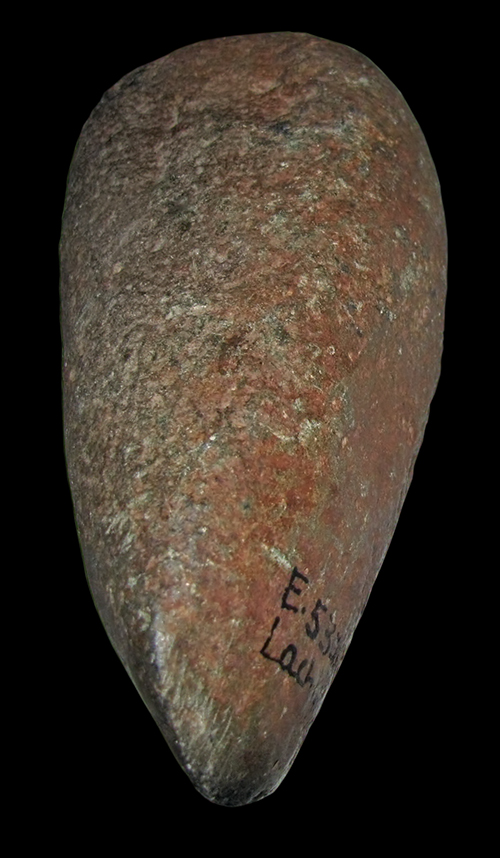
Bogan pick.
( Bogan picks are somewhat enigmatic. Most are around 2kg in weight. Many are sharpened to a point, and have a deep circumferential groove around the blunt end to accept a handle. They have been interpreted by some as a hoe.
This one seems to have been used as an adze rather than a hoe, and it has a 'point' (actually an edge) shaped like an adze, with what appear to be wear marks consistent with use as an adze or (less probably) a hoe.
The undamaged edge must not have had contact with rocks, it appears to be in pristine condition, so if used as a hoe it must have been in conditions where there were no rocks in the soil. The shores of the Lachlan River or the floodplain would provide this condition.
The polish on the faces of the edge is most unusual, and the edge has been very carefully ground to a sharp state. This makes me think that it is definitely not a hoe, but an adze, and what is more, a very carefully made and maintained one. It is a superb tool.
Despite this careful preparation, the specimen has only a rudimentary groove visible on one side, with presumably another similar one on the other side, perpendicular to the line of the ground edge as would be expected for an adze, in order to accept a handle - Don )
Collected at the Lachlan River, New South Wales, before 1896 by an unknown collector.
Source: Sydney Museum
Photo: Don Hitchcock 2010

Silcrete round-edged scraper.
Collected on the surface of the Lake Mungo backshore, New South Wales, by H. Allen, 1970-1971.
Source: Sydney Museum
Photo: Don Hitchcock 2010

Silcrete notched scraper.
( Notched scrapers are very useful for rounding and scraping a spear/dart shaft to a uniform thickness and shape - Don )
Collected on the surface of the Lake Mungo backshore, New South Wales by H. Allen, 1970 - 1971.
Source: Sydney Museum
Photo: Don Hitchcock 2010
Silcrete and chert bondi points.
Collected at Bondi Beach, NSW by T. Whitelegge, 1899.
Source: Sydney Museum
Photo: Don Hitchcock 2010
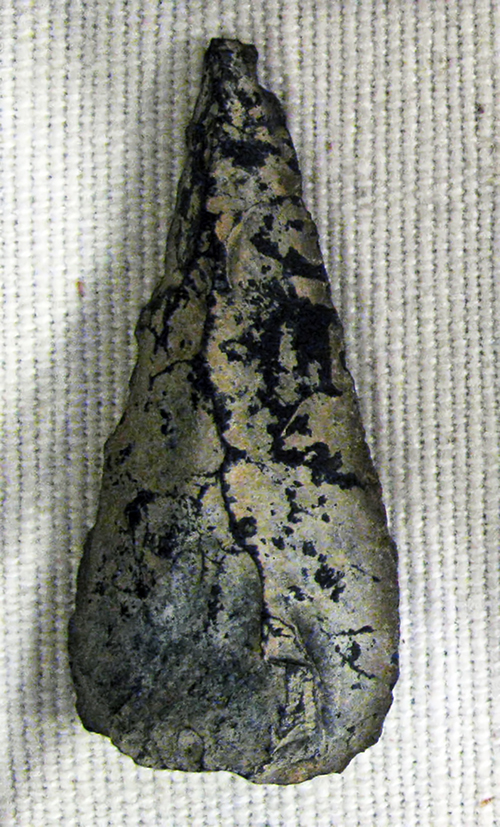
Unifacial Pirri point.
Pirri points date to after circa 5 000 BP, and they document the earliest use of the pressure-flaking technique in Australia.
Pirri points were named by the ethnographer George Aiston in the 1920s, applying the term for them used by Diyari and Wangkangurru people near Lake Eyre in Central Australia. 'Pirri' referred to pointed engraving tools for woodworking made in the historic period, although similar tools were likely used as armatures for spearthrower darts in the past. They usually measure between about 20 mm and 40 mm long, although larger examples are known.
Pirri points were made by pressure flaking - this manufacturing technique is the type's defining characteristic – and they are the earliest evidence in Australia for the pressure technique. Retouch was mostly unifacial, towards the dorsal surface of the blank, although the platform and bulb was sometimes reduced by bifacial flaking. Pirri points typically have a prominent central ridge down the dorsal face with the pressure flake scars terminating at this ridge. Well-spaced collateral pressure flaking scars are visible on many pirri points. Some pirri points were made on blade-like flakes. Pressure flaking spread from Central Australia to the Kimberley region of Northwest Australia by circa 1 400 BP, where a bifacial variant was innovated and used to make Kimberley points through to the 1970s.
Aiston observed a Wangkangurru stoneworker manufacture a pirri point in the 1920s near Oodnadatta. Aiston's informant was making a pointed tool for engraving wood, rather than a dart point. The knapper first secured the flake blank at right angles to a stick using pitch and unifacially retouched the exposed margin by percussion with a hammer stone. Next he took the blank from the pitch, rotated it, re-embedded it into the pitch, and retouched the opposite margin. After this, the blank was taken from the pitch again, set on a grinding stone anvil, and the distal end was unifacially pressure flaked to a sharp point using the ventral surface of ‘a worn-out scraper that has thickened up into a "bull-nose" through use’. The combination of percussion and pressure flaking contrasts with pirri points from the archaeological record, which were made entirely by pressure flaking.
( Note that it would seem that the phrase 'at right angles to a stick' may well mean longitudinally along the stick so that it is supported at all points. I believe that only by placing it in this way could the retouching be possible. I have never heard of this method (which could also have worked well used spinifex resin or similar rather than pitch), but it is obviously a very clever way to work with small flakes. Even carefully prepared mud using clay could be used at a pinch - Don )
Aiston noted in 1924 that 'the art of making these seems to be lost among the tribes here', and that the ones he saw made did not match the expertly fashioned tools in the archaeological record. Only one elder was able to demonstrate the pressure flaking method. Aiston's informants requested that he give to them the ancient pirri points he found so they could re-use them as engraving tools. The well-spaced pressure-flaking scars on many ancient pirri points suggest that a different technique was used from that observed by Aiston.
Collected at Salt Sea, Western Australia by L. Fordon-Bellgrave, 1956.
Photo: Don Hitchcock 2010
Source: Sydney Museum
Text: Professor Mark Moore of UNE Armidale, from his superb website, stonetoolsmuseum.com
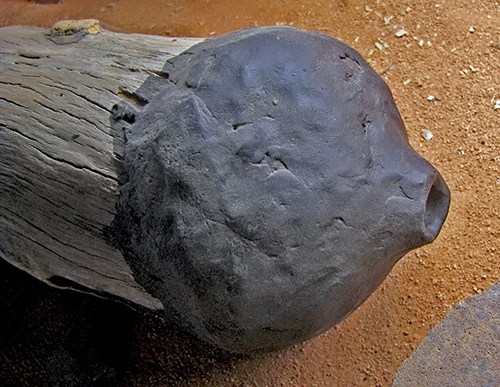
This is a relation of the didjeridoo, about 60 cm in length, called an ulpirra, used as a magic charm for obtaining wives.
Note that the mouthpiece has been made with spinifex resin, which I have heard First Nations people call 'blackfella araldite'. Spinifex resin was a crucial ingredient in spear-making, as the head was often fastened onto the shaft using this resin.
A man would always carry at least one spear, and normally a lump of resin. In the evenings, repairs were carried out on spears and other utensils, and the resin was re-softened using the fire and some moisture.
Many species of spinifex are extremely resinous, to the extent that resin may drip down the stems and leaves on hot days, and large residual lumps of resin often may be seen at the bases of spinifex hummocks which have burned.
Photo: Don Hitchcock 2009
Text: Adapted from Wikipedia
Source: Display, Lake Mungo NPWS interpretation centre
At an elementary stage in the development of blowing techniques, areophones sounded by vibrating, or 'buzzing' the lips inside a tube, may have been more widely distributed in Australia than at present.
Some evidence for this is to be found in the literature on central Australian groups. Spencer and Gillen (1899) refer to a 'rudimentary trumpet" (60cm. In length) called ilpirra or ulpirra.
This was used by First Nations men as a magic charm for obtaining wives. C.Strehlow (1908: 77 and Teil IV,p.15) shows illustrations of the tjurunga ulburu and the karakara, the latter used in an Aranda Itata, or public celebration in which women participated. T.G.H Strehlow (1947: 78-9) writes of a 'low toned wooden ulbura trumpet' used by southern Aranda people on the Finke River. The instrument is pictured representing the neck (rantja) of a venomous snake 'playfully "biting" a novice from another Aranda group' (picture facing p. 89). Eylmann (1908) refers to wooden and bamboo trumpets; and his illustrations include a 'Trompete der Waramunga', that is of a desert group in area C. (The southern part of the Northern Territory)
Text above from: aboriginalart.com.au/didgeridoo/myths.html
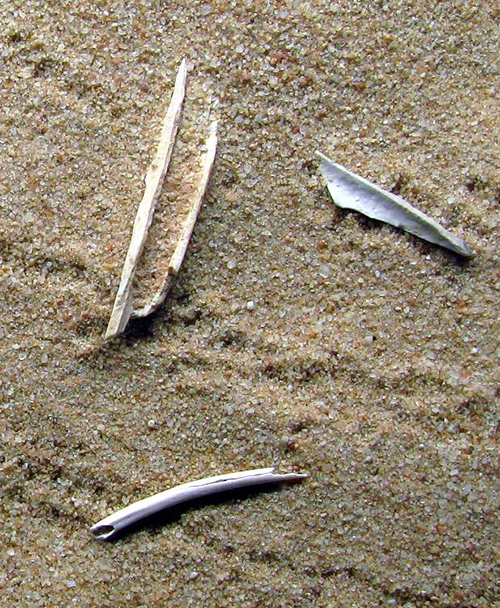
Bird bones. Presumably these would have been sometimes used as fine and sharp bone tools after the bird was plucked and eaten.
Photo: Don Hitchcock 2009
Source: Display, Lake Mungo NPWS interpretation centre
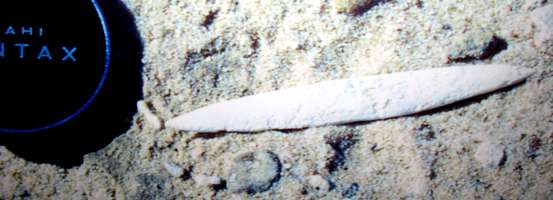
Bone carefully sharpened at each end, probably for use as an awl, making holes in skins to fashion into cloaks, an essential item of clothing in the cold conditions of the ice age.
Photo: Don Hitchcock 2009
Source: Display, Lake Mungo NPWS interpretation centre
Dilly bag made with two ply string, and containing three emu eggs.
These bags are used for gathering bush tucker (food) and are usually worn around the head.
The fibre used for the making of bush string is bark, stripped from certain species of sapling trees. The inner bark is removed, chewed or pounded and then spun by twisting and rolling with the palm of the hand along the thigh a few strands at a time. Colours are obtained by boiling the unspun fibre with local roots and bulbs. Bush string is also widely used for making headbands, armlets, harnesses and other ceremonial regalia.
Photo: Don Hitchcock 2009
Text: www.flight-toys.com/artifacts/gh23.html
Source: Display, Lake Mungo NPWS interpretation centre
Display Cabinet
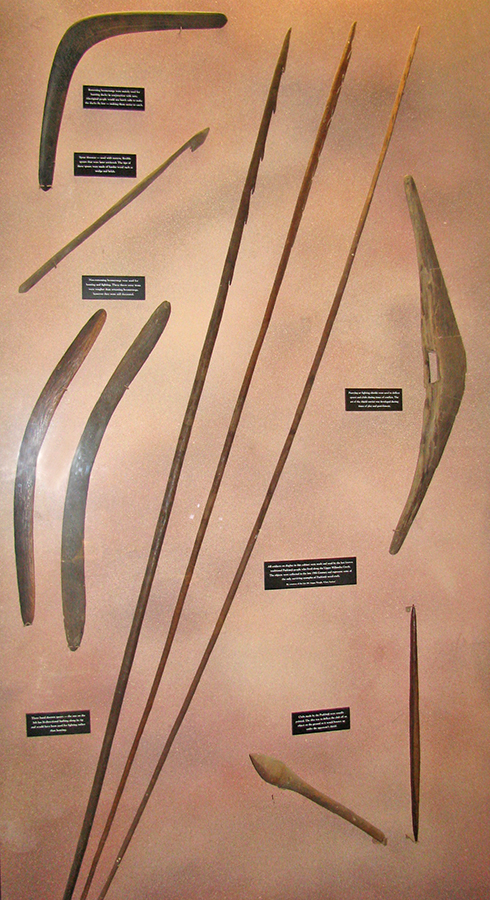
All artefacts on display in this cabinet were made and used by the last known traditional Paakintji people who lived along the Upper Willandra Creek.
The objects were collected in the late 19th Century and represent some of the only surviving examples of Paakintji wood craft.
By courtesy of the late Mr Angus Waugh, 'Clare Station'.
Photo: Don Hitchcock 2009
Source: Display, Lake Mungo NPWS interpretation centre

Parrying or fighting shields were used to deflect (hand-held) spears and clubs during times of hand-to-hand fighting. The art of the shield carrier was developed during times of play and punishment.
Photo: Don Hitchcock 2009
Source and text: Display, Lake Mungo NPWS interpretation centre
Artists in the southeastern region of Australia formerly created two distinct varieties of fighting shields, each designed for a specific purpose. The first were relatively broad, flat forms, which were used to protect the bearer from projectile weapons, such as spears, throwing clubs, and boomerangs, thrown by an enemy at a distance.
The second type were narrow, compact parrying shields, used to ward off blows from fighting clubs and other handheld weapons during hand-to-hand combat. Originally gripped by the handle visible at the left and held with the narrow edge at the right toward the opponent, this parrying shield is adorned with a series of engraved zigzag motifs. There is virtually no historic information on the significance of the patterns on southeastern shields. However, they possibly represent emblematic designs symbolic of the owner's group affiliation or dreamings, the ancestral beings whose actions created the features of the landscape during the Dreaming (primordial creation period).
Text: www.metmuseum.org/TOAH/ho/10/oca/ho_1978.412.865.htm
Clubs made by the Paakintji were usually pointed. The idea was to deflect the club off an object on the ground so that it would bounce up under the opponent's shield.
Photo: Don Hitchcock 2009
Source and text: Display, Lake Mungo NPWS interpretation centre
Three hand thrown spears.
( as opposed to being used with a spear thrower, these were for thrusting and throwing, and were much heavier - Don )
The one in the centre has bi-directional barbing along its tip and would have been used for fighting rather than hunting, and probably the one on the right, since the barbs are quite small.
Non-returning boomerangs such as the two on the left were used for hunting and fighting. These throw away items were rougher than returning boomerangs, however they were still decorated.
Photo: Don Hitchcock 2009
Source and text: Display, Lake Mungo NPWS interpretation centre
Returning boomerangs were mainly used for hunting ducks in conjunction with nets.
First Nations people would use hawk calls to make the ducks fly low - making them easier to catch.
The spear thrower or woomera was used with narrow, flexible spears that were later retrieved. The tips of these spears were made of harder wood such as mulga and belah.
Photo: Don Hitchcock 2009
Source and text: Display, Lake Mungo NPWS interpretation centre
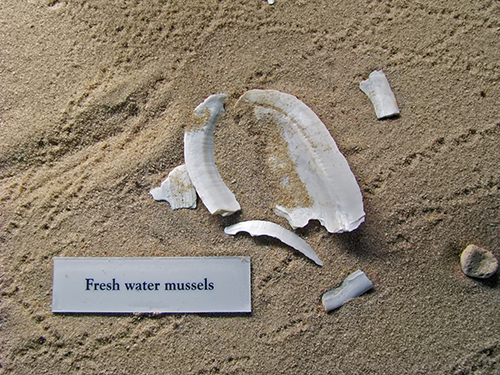
Fresh water mussel shells. These formed a significant part of the diet of the First Nations people of the area, being nutritious, plentiful, and easily gathered from the shallow lake.
Photo: Don Hitchcock 2009
Source: Display, Lake Mungo NPWS interpretation centre

This mortar would have been used for grinding seeds and other food items.
Photo: Don Hitchcock 2009
Source: Display, Lake Mungo NPWS interpretation centre
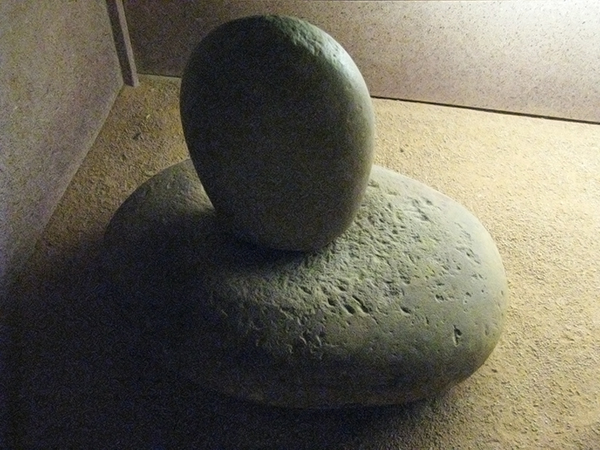
This mortar and pestle would have been used for grinding seeds and other food items.
Mortars and pestles were used for dry pounding and grinding of hard shelled seeds. The stone for this task had to be tough enough to withstand the pounding. The roots of mulga and mallee were also prepared using this process. They were peeled, roasted in ashes, pounded between stones and eaten. Grindstones were traded throughout the region. The stone for these grinding tools was transported from the Ivanhoe area.
Photo: Don Hitchcock 2009
Source and text: Display, Lake Mungo NPWS interpretation centre
Mullers (a smaller hand held stone) and millstones (typically large, fairly flat 'anvils') were used with water to process soft shelled seeds from plants and grasses. The surface of the stone was often pitted to make grinding easier, but the typical result of many hours of grinding was this very flat surface. Grindstones were essential for grinding seeds to make a dough for baking.
Photo: Don Hitchcock 2009
Source: Display, Lake Mungo NPWS interpretation centre
I found this fragment of a millstone, apparently of very good quality sandstone, in the general area of the 'Walls of China' where the loop road crosses it at the southern end of Lake Mungo.
It was very thin indeed, possibly handed down from mother to daughter. It must have been a sad day when it broke. Stones of this size and quality have to be brought into the Lake Mungo area from elsewhere, probably from the Barrier Range near Broken Hill, one of the closest areas where this type of stone can be found, and at least 250 km away.
Photo: Don Hitchcock 2009
Additional text: academytravel.com.au, crcleme.org.au/RegLandEvol/NthBarrierRanges.pdf
(as always, click on the thumbnail above to see the original, larger image)
This superb tool is most unusual for one found at Lake Mungo, in that it has many facets, or flakes, taken from it. Most tools at Lake Mungo are very simple, not because
the maker lacked skill, but because the silcrete used was difficult to work with, as noted above.
The local silcrete is a coarse material, rather like a very hard sandstone, but in which silica (SiO2) has enriched the rock so that it is very hard. It is not possible to make fine tools with the local silcrete, and it is not possible to do the 'retouch' of very fine flakes which are typical for fine work in Europe. Where the First Nations people did have good silex/flint to work with, for example in the north of Australia, they made tools which are the equal of the best European tools.
You can see in this photo the very coarse nature of the silcrete. The person responsible for the knapping of this tool was a master, working with a difficult material.
They would have been justifiably very proud indeed of this work of art.
Photo: Don Hitchcock 2009

This simple piece, what I think of as a 'point', is much more typical of the sort of tools that were
made. The tool maker had one chance to make a usable tool, and there
was little possibility of further work to refine the shape.
It should be realised that all the stone in the area had to be brought
from twenty kilometres away on the western side of the lake. If you
find a stone, it was transported there 40 000 years ago by First Nations people.
There is no local stone, apart from some very small pebbles on the
lake edge, of no use for tools, but which were sometimes used in the
making of a hearth.
Photo: Don Hitchcock 2009
Two photos of the same tool.
Many of the tools at Mungo are of this type - what I think of as a "point" or a "finger". The ones found which are thin and elongated often have been broken off at the tip, as this one has.
I was initially puzzled as to what they were used for, and why, so often, the tip had been broken off, as though the point had been twisted to the point where it sheared off. There are so many that they must have provided a common and useful function.
The most likely use is to prise open the mussels which constituted a very large part of the menu when Lake Mungo was full of water. This would explain why so many were made, and why so many of them have the tip broken off.
Photo: Don Hitchcock 2009
A point with the end broken off. The subtriangular cross section of this tool is very common in the Mungo toolkit.
Photo: Don Hitchcock 2009
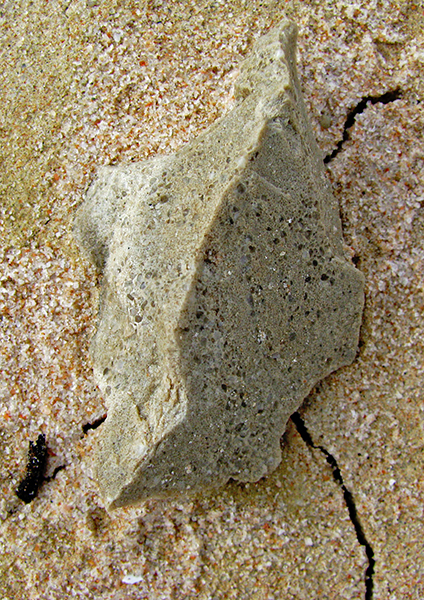
A blunted point, with a second point broken off on the other end.
Photo: Don Hitchcock 2009
Broken points.
Photo: Don Hitchcock 2009
Points of inferior stone.
Photo: Don Hitchcock 2009
This point has had a checkered career, apparently having been resharpened at one stage.
Photo: Don Hitchcock 2009
It is interesting how often this particular shape was produced, it must have been close to the ideal shape for purpose, within the limits of what could be achieved with the raw material.
Photo: Don Hitchcock 2009
Broken point, of colourful but inferior material. Many of the tools show their origin as small or large pebbles, with the outer layers oxidised to a lighter or darker colour.
Photo: Don Hitchcock 2009
Apparently a denticulate backed blade, still embedded in the sand.
I did not disturb any of these specimens.
Photo: Don Hitchcock 2009

A badly damaged point, standing on its end after the surrounding sand was washed or blown away.
Photo: Don Hitchcock 2009
Probably used as scrapers.
Photo: Don Hitchcock 2009
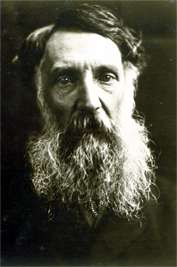
An eyewitness account
The following extract is an observation of a First Nations oven hearth being made in the last century.
'The native oven is made by digging a circular hole in the ground, of a size corresponding to the quantity of food to be cooked. It is then lined with stones in the bottom (or clay balls where stones are unavailable), and a strong fire made over them so as to heat them thoroughly, and dry the hole. As soon as the stones are judged to be sufficiently hot, the fire is removed, and a few of the stones taken, and put inside the animal to be roasted if it be a large one. A few leaves or a handful of grass, are then sprinkled over the stones in the bottom of the oven, on which the animal is deposited, generally whole, with hot stones... laid on top of it. It is covered with grass, or leaves, and then thickly coated over with earth, which effectually prevents the heat from escaping.'
Edward John Eyre, 1845.
Photo: The Australian National Portrait Gallery, http://www.portrait.gov.au/
On my 2009 trip to Lake Mungo in the south of New South Wales I found more than a dozen hearths/ovens on the eastern side of the former lake. The First Nations people from 40 000 BP who lived there used to put stones, or clay from termite mounds (stone was very hard to get, twenty kilometres away on the other side of the lake) in the bottom of a pit, get a decent fire going, then take out the coals, line it with grass and leaves, put a few of the stones inside the bird or animal, put hot stones on top of it, more grass and leaves, then cover with more earth or sand, wait several hours, then dig it up and have dinner.
This photo is of an oven about 50 cm across which has used the clay pieces. I found others where they often used much smaller stone fragments which may well have been debitage from knapping of usable silcrete pebbles, as well as larger, unworked pebbles of poor quality, probably brought in dilly bags from the other side of the lake, a long days walk each way, just for ovens.
In this case at least the clay from the termite mounds was not softened with water and formed into balls, it was simply broken from the termite mound and brought to the site. The pieces are angular fragments, and of greatly varying sizes.
Photo: Don Hitchcock 2009
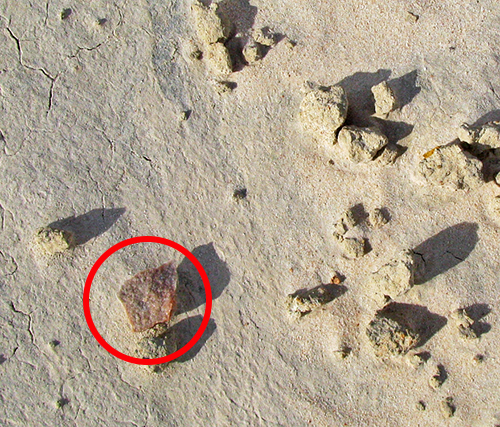
This tool, possibly a point used to open mussels, was left beside the hearth in the image above.
It is to the far upper left of the photo above.
Photo: Don Hitchcock 2009
This hearth/oven had begun to be dispersed by water and wind. It seems to me that the weather breaks up the clay pieces fairly quickly into smaller pieces, after exposure to the elements.
Photo: Don Hitchcock 2009
Parts of the lunette are being very actively eroded, especially by water. Note the small bush which has been undermined, and is hanging down the sand face.
Photo: Don Hitchcock 2009
At least the erosion exposes things such as these hearths/ovens in the sand face of the photo above, with their clay balls used to help cook game in earth ovens.
Photo: Don Hitchcock 2009
Occasionally the hearths were made of poor quality stone, useless for tool making, but fine for earth ovens. Clay is actually very slightly better than silcrete for this purpose, with clay having a specific heat capacity of 878 J/kg.°C and sandstone (silcrete being made up of sandstone, with a matrix of silica) at 740 J/kg.°C, and silica itself at 680 - 730 J/kg.°C, though estimates vary between sources.
The stone in closeup on the right (to be found at the immediate foreground of the general shot on the left) is typical of the stones I found in earth ovens. They are usually blackened, often with the white deposit so obvious in this photograph.
Photo: Don Hitchcock 2009
Source for specific heats: theengineeringmindset.com/specific-heat-capacity-of-materials/ and www.azom.com/properties.aspx?ArticleID=1114
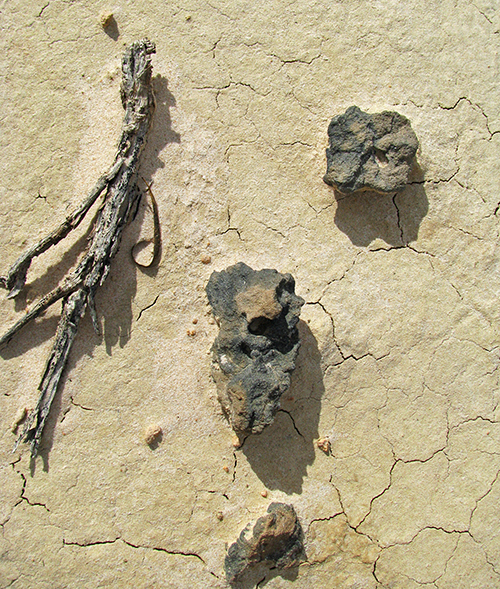
Hearthstones were usually quite small, often no more than six or seven centimetres in their longest dimension.
Photo: Don Hitchcock 2009
Cooking with a Compass
Many fireplaces can be found around the Willandra Lakes area. These ancient ovens not only reveal the ways early inhabitants of Mungo cooked their food. Scientific research of the fired lumps of clay found in these hearths proved that the earth changed its magnetic field.When north was east-south-east
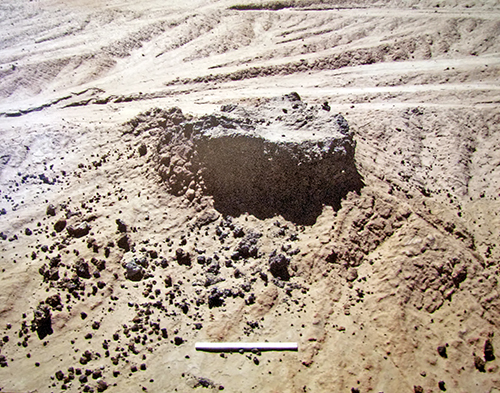
(This is identified at the Lake Mungo NPWS interpretation centre as a photo of Barbetti's hearth - layered charcoal on a baked clay bed. Scattered clay balls surround it.)
In 1973 Dr Michael Barbetti
(Barbetti et al, 1973) provided the first new dating method of ancient First Nations fireplaces.
Rephotography: Don Hitchcock 2009
Source and text: Display, Lake Mungo NPWS interpretation centre
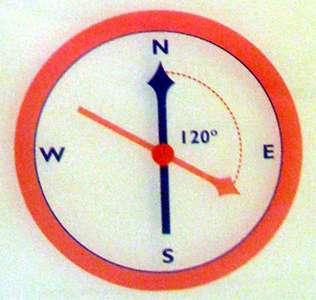
The study of clay lumps found in fireplaces revealed an amazing phenomenon. The clay lumps act like a compass - recording the direction of the earth's magnetic field at the time of heating and use. From studies of Mungo's clay lumps, it was discovered that the earth changed its magnetic field about 30 000 years ago. This event has been termed the 'Mungo Excursion'.
Rephotography: Don Hitchcock 2009
Source and text: Display, Lake Mungo NPWS interpretation centre
Edited abstract from: Barbetti et al (1976):
Archaeomagnetic studies have been made of prehistoric First Nations fireplaces occurring along the ancient shore of Lake Mungo, a dried out lake in southeastern Australia. Directions of magnetization preserved in ovenstones and baked hearths show that wide departures of up to 120 degrees from the axial dipole field direction occurred about 30 000 years ago.
The geomagnetic excursion of up to 120° recorded between at least 30 780 ± 520 and 28 140 ± 370 years BP on the conventional radiocarbon time scale is associated with very high field strengths between 1 and 2 Oe (1 Oe ≈ 79.6 A m-1). The field strength subsequently decreased to between 0.2 and 0.3 Oe after the excursion. This main excursion is referred to as the Lake Mungo geomagnetic excursion. There is evidence that a second excursion associated with low field strengths of 0.1-0.2 Oe occurred around 26 000 years b.p. A review of geomagnetic excursions less than 40 000 years in age shows that it may be premature to assume that these are world-wide synchronous features. The range of ages and their groupings in different parts of the world may indicate they are temporary non-dipole features of continental extent. However, the duration of most excursions (order of 103 years) is very similar to that of polarity transitions and this could indicate they are aborted reversals.
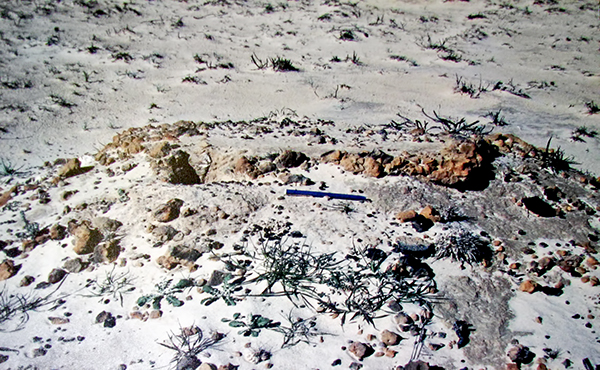
Remains of an ancient oven found on the Mungo Lunette.
The eroded remains of three varieties of fireplaces found at Mungo National Park are:
Ovens: consist of cooking stones (or lumps of baked clay balls or broken termite nests) arranged on top of a thin layer of ash and charcoal in a shallow depression.
Hearths: are areas of blackened earth without heat retaining stones, resulting from an open fire.
Mounds: consist of baked clay heaped above layers of charcoal and ash below. Their purpose is unknown.
Rephotography: Don Hitchcock 2009
Source and text: Display, Lake Mungo NPWS interpretation centre
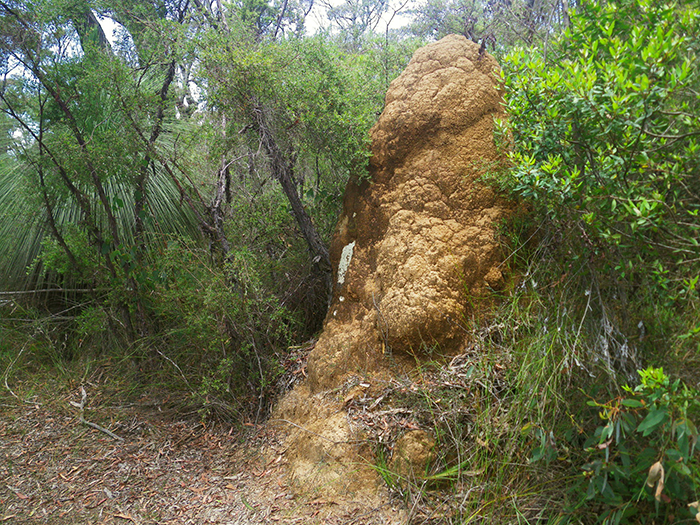
This example of a termite mound is situated in the highlands of Eastern NSW, near Mulligan's hut.
Photo: Don Hitchcock, January 2012
Other dating methods and background
Edited extract from Gillespie (2002):
Mungo is one of the icons of Australian archaeology; Lake Mungo is one of a series of large lakes formerly part of the Murray-Darling river system that drains a large fraction of eastern Australia. These Willandra lakes are now permanently dry, but during the Late Pleistocene they contained large quantities of fresh water which attracted some of the earliest residents. A National Park and World Heritage Area is centred on Lake Mungo, reflecting the wealth of archaeology and environmental history.
Large-scale archaeological excavations were carried out in the early 1970s near the south end of the Mungo lunette, penetrating more than 2 metres to sterile sands. TL dating of heated sediments from under, and heat retainers within, hearths in the Mungo lunette overlap with calibrated 14C dates on charcoal from the same fireplaces in the range 34 ± 3 ka. This period of human occupation coincides with deposition of Arumpo Unit sediments although the hearths are dug into older units.
The oldest 14C dates on charcoal, emu eggshell, lacustrine shell, and fish otolith at 40 ± 3 ka are from locations close to a transition zone in the lunettes, where clay-rich sediments derived from the lake floor during times of lower, fluctuating water levels (Upper Mungo Unit) overlie quartz dominant sediments from a high lake level phase (Lower Mungo Unit). TL dates on unheated sediments are widely scattered and not consistent with the 14C record. Ongoing new work suggests that the Upper Mungo occupation horizons are close to 44 ka.
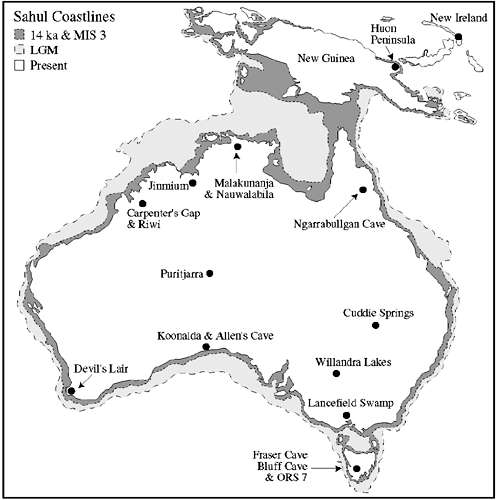
Map of the Australian region showing the extended Sahul landmass at
Last Glacial Maximum (20 000–24 000 BP) and 14 000 BP (as proxy for Marine Isotope Stage 3), modified after Smith (1998).
Photo and caption: Gillespie (2002)
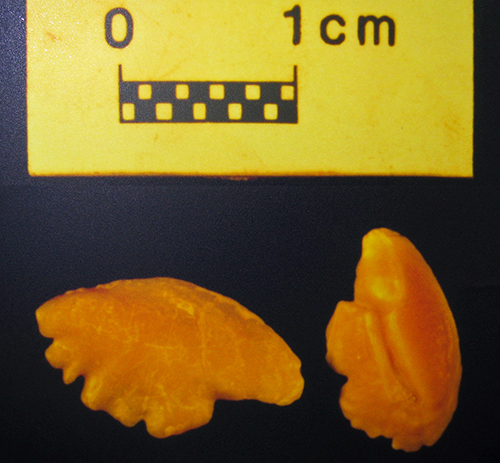
Each time strong winds or rain occur in the Willandra region more evidence of the past is uncovered on the lunettes.
Some of that evidence is tiny but provides a great story. From the small otoliths (or 'ear stones') of the Golden Perch or Murray Cod scientists can tell how much the fish weighed and their exact age at death.
The otoliths have microscopic growth bands, much like tree rings. These bands also preserve details of water chemistry at the time. So not only can we learn about lake temperatures and salinity, we can even know in which season the fish was caught.
Rephotography: Don Hitchcock 2009
Source: Display, Lake Mungo NPWS interpretation centre<
Tools and ecosystems from the lunette where the loop road crosses it at the southern end of Lake Mungo
Map of the south of Lake Mungo, showing where the loop road crosses the lunette at the southern end, and continues north behind and to the east of the lunette, towards the Vigars Well picnic area.
Photo: Google Maps
The area has been badly degraded by erosion. The backshore and crests of the dunes alternate between broad, flat, hard surfaced, bare areas like this, and 'badlands' areas with heavily furrowed slopes.
Photo: Don Hitchcock 2009
This lone tree appears to be in good condition, although the remains of a previous tree lie at its base.
Trees like this help to restore the former vegetation which had been devastated by feral rabbits, and help contain soil erosion.
Photo: Don Hitchcock 2009
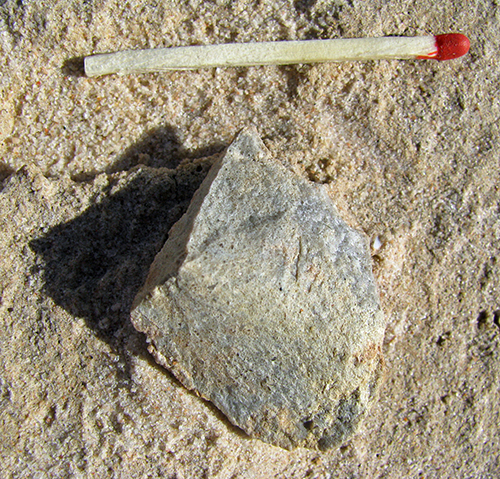
Tool - a combination scraper and point.
Photo: Don Hitchcock 2009
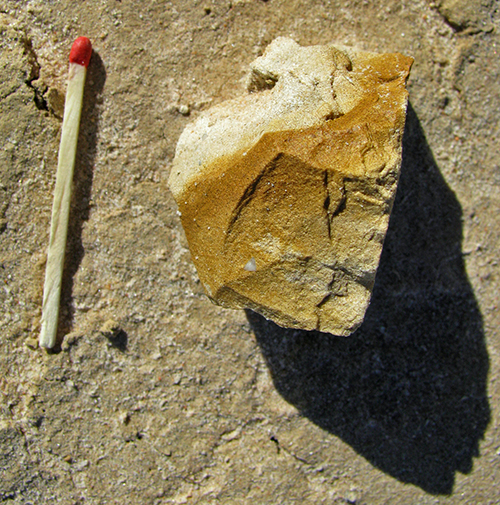
Possibly the remains of a core, although it may have been used as a small rough-and-ready rabot or wood planer.
Rabots are defined as heavy 'push-plane' scrapers made on blocks or thick flakes, abruptly retouched.
Photo: Don Hitchcock 2009
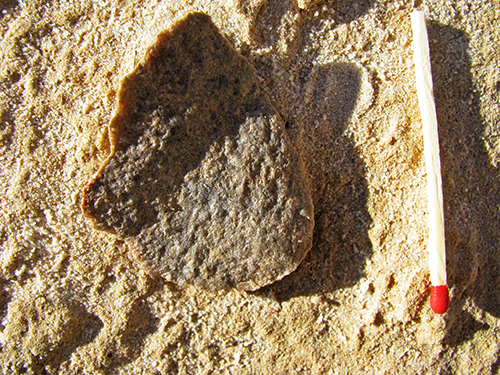
Scraper.
In 2009 I began taking taking photos of the tools in a larger format, and with a camera which permitted high quality close-ups, giving a much better look at the surface of the tools, and allowing an estimate of their granularity.
As can be seen here, the residents here had mostly very poor materials to work with. Fine work was impossible for the coarser silcrete. All that could be accomplished in this case was the production of strictly utilitarian tools which did the job, not works of art.
Photo: Don Hitchcock 2009

This was originally a point, now with the point broken off, probably used for opening shells. These tools form the majority of types in some areas of the lunettes.
Some, like this one, had little care lavished on their production.
Photo: Don Hitchcock 2009
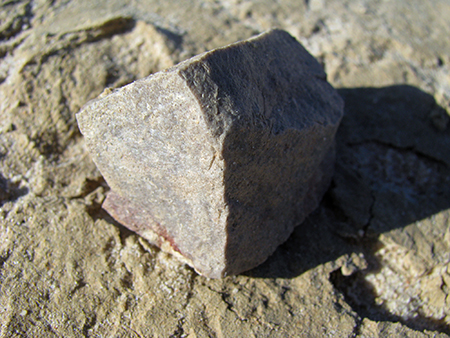
These sub-triangular remnants of tools are very common, and were obviously the easiest to manufacture for a range of uses. Many are possibly the remains of broken points for opening mussel shells.
Photo: Don Hitchcock 2009
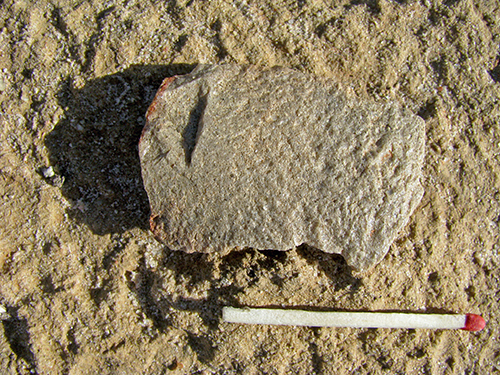
Various scrapers, knives, and flakes.
Photo: Don Hitchcock 2009
Scrapers.
Photo: Don Hitchcock 2009
It is unusual to find such a well rounded pebble as this one in the dune deposits. However it would seem to indicate that at least part of the silcrete deposit had included pebbles transported by streams.
Connolly (1985) writes about the silcretes in the Armidale NSW region, that:
The sand and pebbles are cemented by silica to form a hard material that usually fractures through pebbles rather than around them. There are good exposures of this silcrete type on hilltops 11 km southwest of Armidale.... The pronounced rounding of pebbles in these silcretes indicates possible transport in streams. Despite the usual strong silicification of these pebbly silcretes, the silica cement in many samples has weathered more rapidly than the pebbles it is binding. For this reason exposures of these cemented poorly sorted sediments often have portions of rounded pebbles standing in relief above the quartz sand matrix.It is also unusual to find a pebble such as this on the former lake shore, of apparently tool quality stone, but unchanged in form. It may have been collected on the western side of the former lake, transported to the eastern shore, and then kept in the toolkit as a core ready for use as necessary. It may also have been used as a hammer stone, though there was no obvious evidence of the wear/pitting you would expect if this were the case.
Photo: Don Hitchcock 2009
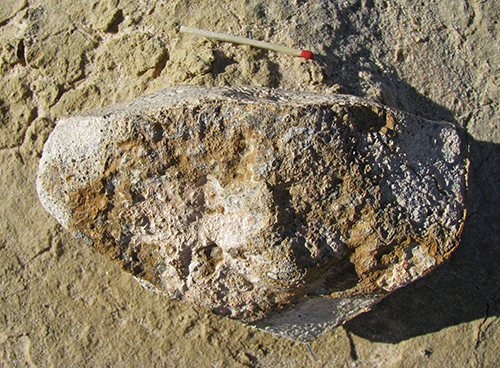
This pebble is still coated with a cortex, and has not been checked for its suitability as a source of tools.
Pure flint, another form of quartz, often has a similar powder like coating.
Photo: Don Hitchcock 2009
This is an unusually shaped stone, shown at left in situ. It appears to have a bulb of percussion with a fringing flat area, presumably as the wave front of the blow which created it reached a cleavage plane deeper in the core.
Photo: Don Hitchcock 2009
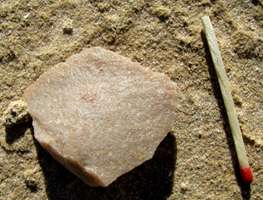
This is a particularly homogenous piece of pink silcrete, fashioned into a knife/scraper. Such good quality stone is rare in this area.
When the Overland Telegraph Line was put in across Australia in 1872, a 3200 km telegraph line that connected Darwin with Port Augusta in South Australia, the builders had a lot of trouble at first with the First Nations people taking the ceramic (or glass) insulators to use for stone tools. They also took lengths of wire from the line to fix stone axe heads to handles. The workmen finally decided to leave behind off cuts of wire and broken insulators at the foot of the poles whenever they went to repair faults in the desert country, and the incidence of line faults dropped by 80% in three months, a fine example of lateral thinking.
Text above adapted from: http://www.abc.net.au/rn/science/ss/stories/s1515660.htm
Photo: Don Hitchcock 2009

This fine scraper was nearby, again made from relatively good quality white silcrete, or at least as good as was available.
Photo: Don Hitchcock 2009
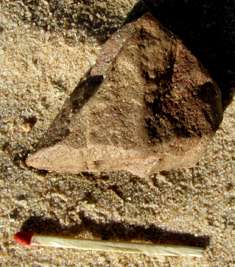
This is a well-worn point, no doubt worn from opening hundreds or thousands of mussel shells. It has lost all its sharp edges, but would still have been a useful tool.
Photo: Don Hitchcock 2009

An enigmatic tool, a pebble with only a few flakes struck from it, as though the knapper decided it was not worth persisting with, yet it seemed to me to be no worse than most materials used for tools.
Photo: Don Hitchcock 2009

This is the best blade I found at Mungo. The knappers were capable of good work when they had half way decent materials to work with. This piece of silcrete is about as good as the raw material ever got.
Photo: Don Hitchcock 2009

Typically the landscape has a standard cross section from the top to the lake bed.
- Some trees and bushes at the top of the lunette
- Extensive bare and planar but tilted areas across much of the lunette, interrupted by small bare hillocks of clay
- Grading into erosion channels and gradually increasing vegetation
- Until the well vegetated lake floor is reached.
This photo shows the first two of these gradations.
Photo: Don Hitchcock 2009
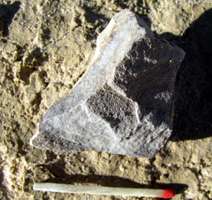
A roughly made though serviceable point.
Photo: Don Hitchcock 2009
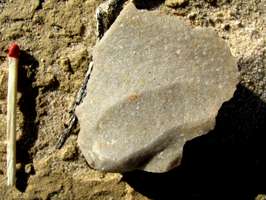
Knife.
Photo: Don Hitchcock 2009
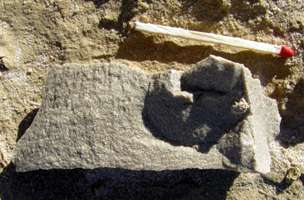
This piece demonstrates the same lack of homogeneity of fracture displayed in the "bulb of percussion" piece I have described above. In this case a utilitarian scraper has resulted.
Photo: Don Hitchcock 2009
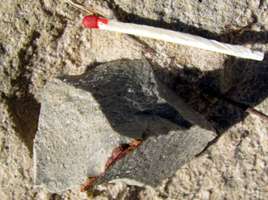
Scraper showing the oxidised outer surface of the original silcrete pebble used for the tool. Trace amounts of iron give the red colour to the stone when exposed to the elements for long periods.
Photo: Don Hitchcock 2009

Scraper.
Photo: Don Hitchcock 2009
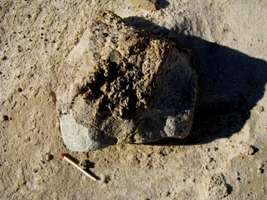
Poor materials and a poor tool, only useful because of its relatively large size. The cortex shows that the original pebble spent a lot of time exposed to the elements or to scarifying ground waters.
In fact, it looks more like an original pebble demonstrating wear when used to prise apart fresh water mussels than a properly knapped tool.
Photo: Don Hitchcock 2009
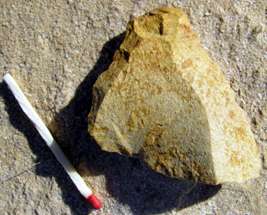
This scraper shows more flakes knocked off it to make a useful tool than is normal in the Mungo toolkit.
Photo: Don Hitchcock 2009
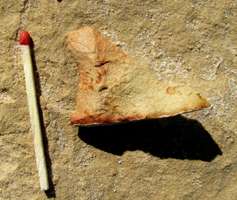
A pretty and delicate little point.
Photo: Don Hitchcock 2009

Spinifex. There may have been very little of this desert plant, if any, at the time when Lake Mungo was full. It produces a thermoplastic resin which is very useful for attaching tools to handles, especially when combined with twine.
Photo: Don Hitchcock 2009
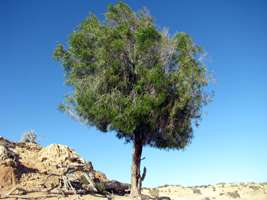
Trees struggle to survive in these difficult conditions, and one that has succumbed can be seen beside this tree valiantly struggling against the odds.
Photo: Don Hitchcock 2009
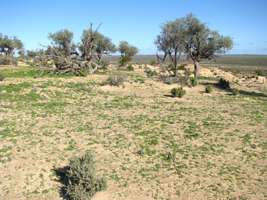
This photo on top of the lunette shows the appearance of fresh green shoots. They may be only annuals, and introduced weeds at that, but at least they stop the soil blowing away for a time. Eventually the lunette will be revegetated, so long as the feral animals can be kept in check, but it is a long slow process. The Australian desert landscape/ecosystem is a very fragile one.
Photo: Don Hitchcock 2009
The Northern Lunette
These tools, shells, bones and location shots are from the northern part of the lunette, where the road comes back across the lunette from its route behind the sandhills, and drops down to the lake.
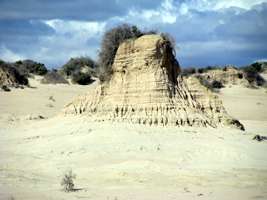
Here we see again the typical erosion surface so evident at the Walls of China.
The top of the lunette, though eroded, has some vegetation. The isolated erosion artefact and the rest of the hard 'pavement' has little or none.
Photo: Don Hitchcock 2009
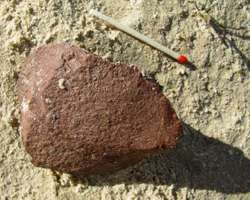
Knife with some evidence of coarse retouching to give a somewhat denticulate, sawing edge. As always, the quality of the stone precluded fine work.
Photo: Don Hitchcock 2009
This piece, found close by the tool above, shows much more obvious retouching to give a coarse denticulate edge.
It would be good to talk to these ancient toolmakers about the problems they faced, and the methods they used to get workable tools. What is certain is that they knew what good material was.
There is evidence from early white contact times that there were thriving trade routes between groups of tribes, and there was trade from the very north of Australia to the very south of the main continent.
One presumes that they accepted that for workaday materials, they had to use what nature had provided. Certainly there were compensations. A long chain of large, permanent, fresh water lakes far from the coast is a luxury which is worth enduring some minor privations to have. Better a highly productive area of fish, shellfish, marsupials, food plants, reptiles and birds but with poor stone tools than the finest stone materiel nature can provide combined with desert conditions, few food plants and poor hunting.
They almost certainly had 'status' stone knives of superb quality. These are known to have been traded from areas where fine quality flint or quartz was readily available to places with poorer materials.
Photo: Don Hitchcock 2009


Burin with a tip blunted from use.
Photo: Don Hitchcock 2009
Scrapers. Many of these have a square or rectangular plan view.
Photo: Don Hitchcock 2009
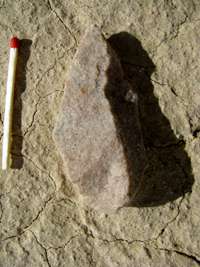
Point, blunted with use.
Photo: Don Hitchcock 2009
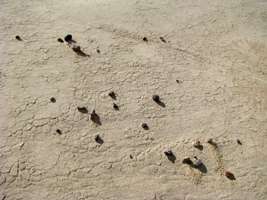
Blackened hearth stones as well as some tools.
Photo: Don Hitchcock 2009
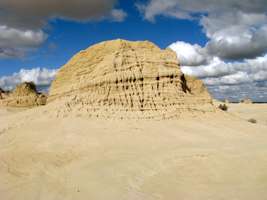
Small hill showing furrowing by rain.
Photo: Don Hitchcock 2009
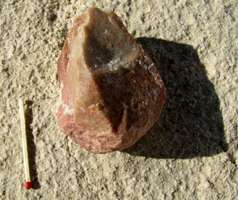
Scraper. The shadow shows the roughly rectangular shape of the tool.
Photo: Don Hitchcock 2009

Point.
Photo: Don Hitchcock 2009
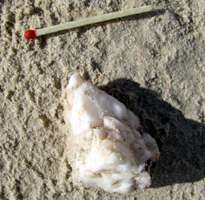
Although this tool is of potentially much better material, quartzite rather than silcrete, unfortunately it has poor cleavage patterns, making it almost useless as a tool.
Photo: Don Hitchcock 2009

This is a very odd tool indeed. Possibly a scraper, every single edge seems to have become rounded, as though it had been made of butter and sat in the sun too long. It cannot be water worn, there are no streams to roll in, and silcrete is immune to pretty much any environment.
It is a very puzzling tool, any guesses as to its present rounded shape are welcome.
Donna Cannon (pers.comm.) suggests that it may have been a pestle which had broken, and was then pressed into service as a groove sander, which would account for the wear on the edges.
Photo: Don Hitchcock 2009

Looking out over the dry Lake Mungo. Just a slight difference in slope makes all the difference to the landscape. From a highly eroded and apparently unrecoverable dune to the well vegetated lake bottom is a matter of only a few metres.
Photo: Don Hitchcock 2009
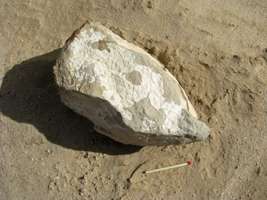
This point, probably used for opening mussel shells, has been only minimally altered for the task, and may not have been altered at all, but has simply worn at the tip from use.
Photo: Don Hitchcock 2009

Mussel shell, possibly 40 000 years old.
Photo: Don Hitchcock 2009
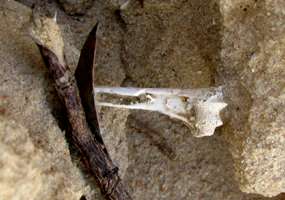
<
Kangaroo bone in situ, possibly 40 000 years old.
Photo: Don Hitchcock 2009
Various bones weathering out of the sandy sediments in close proximity, from an ancient bone midden.
Photo: Don Hitchcock 2009

Another white quartz tool, but of better quality stone, made into a double point, possibly burins.
Photo: Don Hitchcock 2009
One of the classic 'finger' tools, presumably used for opening mussel shells. There appear to be two quite distinct tools for opening mussel shells, a simple point often with triangular cross section, and this 'finger' form.
Photo: Don Hitchcock 2009
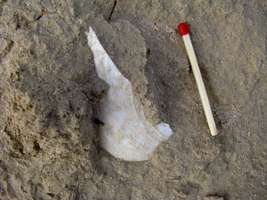
Mussel shell in situ.
No tools or shells or other artefacts were moved or removed during my visit to Mungo.
Photo: Don Hitchcock 2009
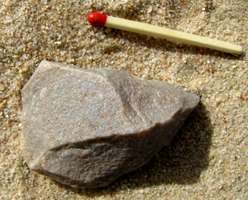
A simple but effective point.
Photo: Don Hitchcock 2009
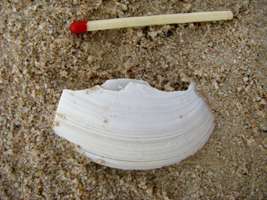
Mussel shell.
Photo: Don Hitchcock 2009
There was a long line of bones and shells leading up to the hill in the background, weathering out at the surface of the sand and clay pavement.
Photo: Don Hitchcock 2009
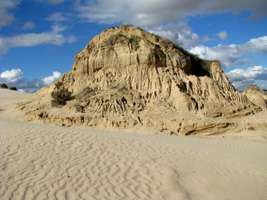
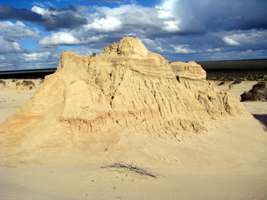
Hillocks left by erosion, some with vegetation, some without, with the lake bed in the background.
Photo: Don Hitchcock 2009
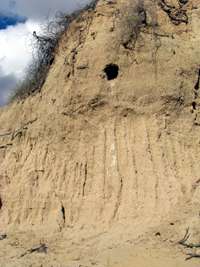
Hollow in the sandy hillock on the left image above, used by a bird as a refuge or nest, as can be seen from the droppings on the face of the hillock.
Photo: Don Hitchcock 2009

Point with the end broken off, showing the sub-triangular cross section of the tool.
Photo: Don Hitchcock 2009
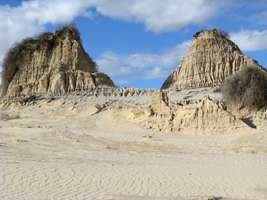
The hillocks record the sand and clay blown onto the lunette at times when the lake was dry. The lake has filled and emptied many, many times. When it emptied, most of the inhabitants had to fall back to the coast or rivers in order to survive. When dry, the lake area could not support so many hunter gatherers.
Photo: Don Hitchcock 2009
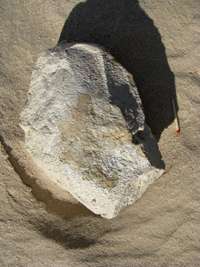
This tool has acquired a patina of white material. It is a point with the tip broken off, with the common triangular cross section which served the toolmakers so well.
Photo: Don Hitchcock 2009
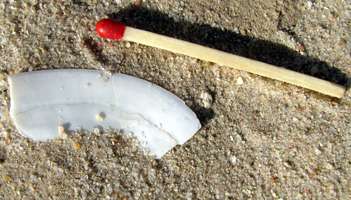
Mussel shell weathering out of the sediments. When Mungo was last full (about 15 000 years ago), Sydney Harbour was a wooded valley 30km inland and Tasmania was at best the Apple Peninsula. Europe was shivering in the Ice Age, Lascaux was the latest contemporary art gallery and people had just started migrating to the Americas. Meanwhile, the long-established Lake Mungo folk were busy cooking Murray cod and golden perch in campfires, traces of which remain as dark smudges in the lunettes.
Text: http://travelinsider.qantas.com.au/mungo_moondance.htm
Photo: Don Hitchcock 2009
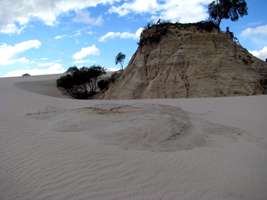
The pattern of wind blown sand augmenting the lunettes has begun again, but this time the material is not coming from the lake bed, but from the sediments eroded from the lunette itself, laid bare because of overgrazing and feral animals such as goats and rabbits.
The sand and clay from the lunettes gets as far as the lake edge, but then since it is unconsolidated, it is liable to wind erosion from the prevailing westerly winds. This sand and clay is now, in places, surrounding and engulfing the ancient sediments as shown here, where this 40 000 year old hillock of sediments is surrounded by freshly redeposited sediments, some no doubt from the hillock itself.
Photo: Don Hitchcock 2009
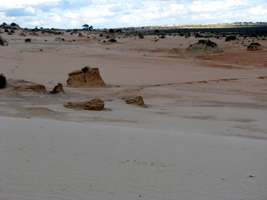
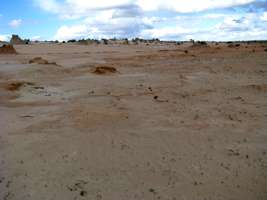
The red Gol Gol layer shown here contains the oldest sediments. It predates human occupation of Lake Mungo. Above the Gol Gol layer is the greyish brown Mungo layer, which is 45 000 to 25 000 years old. At the top is the pale brown to whitish Zanci layer, 25 000 to 15 000 years old.
Photo: Don Hitchcock 2009
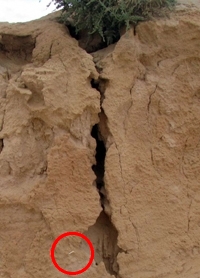
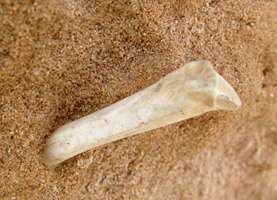
Bone sticking out of the lunette, (circled in situ in the left hand photograph). The end may have been altered by man, but it is difficult to be sure.
Photo: Don Hitchcock 2009
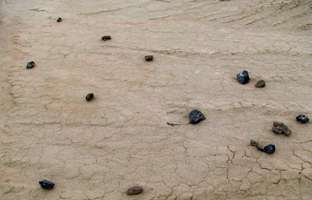
Black hearth stones. These were used to hold the heat when a fire was built on them, the coals removed, meat put on the hot rocks, then covered with more rocks and earth until the earth oven was opened some hours later to reveal cooked meat. Cooking makes more of the nutrients available for absorption by the digestive system, as well as making food more tasty, in most cases.
Photo: Don Hitchcock 2009
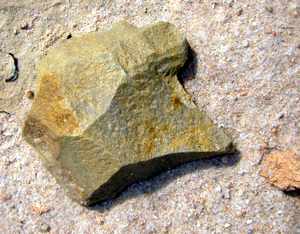
Burin or point of silcrete from Lake Mungo, about 7 cm across. This is one of the finest tools I found in the area, it is beautifully made, from relatively good quality silcrete with a fairly fine grain.
All silcrete on the 'Walls of China' was carried there by First Nations people from the western side of the lake. There is no silcrete available on the eastern side of Lake Mungo.
This tool would originally have had a sharp and narrow point possibly for making holes in skins, which has broken off, and the tool was then thrown away.
The tools are often elegantly made, with the minimum of flakes being removed, and no evidence of retouching. Some have been made by master craftsmen with total control of the sub-standard material.
Photo: Don Hitchcock 2005
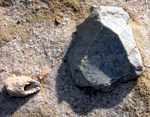
Stone core showing a negative bulb of percussion from a previous blow to remove a flake, and a whelk shell from the lake.
I can imagine the craftsman making tools from the core, and sucking the meat from the shell as he worked.
Photo: Don Hitchcock 2005

Probably a scraper, used in the initial preparation of hides by scraping off the fat on the inside of the skin. This is a beautiful piece of work, done with complete mastery of the admittedly poor material.
Photo: Don Hitchcock 2005
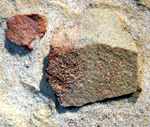
Probably a knife or a wide scraper, about 7 cm across.
Photo: Don Hitchcock 2005
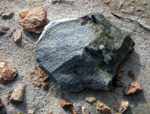
A core and what looks like burnt clay or termite mound from an ancient hearth.
Photo: Don Hitchcock 2005
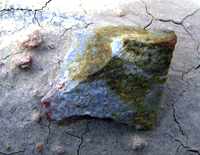
Most likely a burin with the point broken off, or less likely a broken point used to open mussels. Note the oxidation bands still showing from the original pebble from which the tool was made, and the burnt clay from the hearth near which it was laid down.
Photo: Don Hitchcock 2005

The burin above in situ, with apparently burnt, blackened stones and burnt clay.
Photo: Don Hitchcock 2005
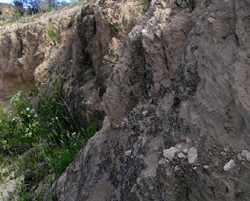
Hearth in situ near the edge of the lake.
Photo: Don Hitchcock 2005

Midden of shells collected from the time when Lake Mungo was full of water. They look like they could have been opened and eaten just a few years ago.
Photo: Don Hitchcock 2005
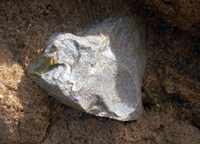
Silcrete tool core in situ poking out from a vertical cut in the sediments. The scarcity of such objects compared with the relative abundance of tools and cores lying on the surface illustrates the effectiveness of the winnowing process of rain and wind in exposing the artefacts.
Photo: Don Hitchcock 2005
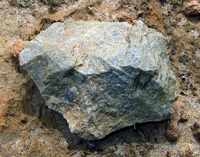
Silcrete core.
Photo: Don Hitchcock 2005
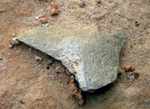
Silcrete blade.
Photo: Don Hitchcock 2005
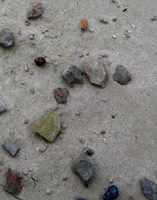

Tools winnowed to the surface by wind and water.
Photo: Don Hitchcock 2005

Burin and one of the ubiquitous caterpillars!
Photo: Don Hitchcock 2005

Shell from a midden looking as though it is only a year or two old - but it is tens of thousands of years since the lake had enough water to provide habitat for shells of this kind.
Photo: Don Hitchcock 2005
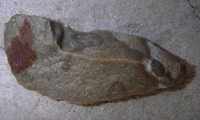
A broken point, probably originally made to open mussel shells.
Photo: Don Hitchcock 2005
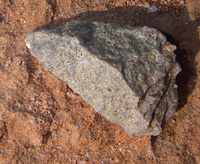
Point.
Photo: Don Hitchcock 2005

Tool.
Photo: Don Hitchcock 2005
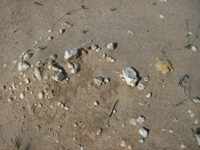
The burnt clay remains of a hearth.
Photo: Don Hitchcock 2005

A tool left behind in a hearth.
Photo: Don Hitchcock 2005
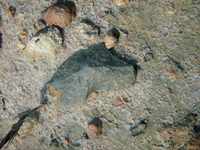
A tool left behind in a hearth.
Photo: Don Hitchcock 2005
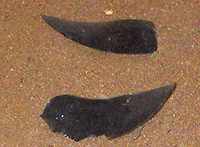
First Nations people were quick to make use of better materials as they became available. After white contact, when glass bottles became available, but before steel knives were common, they made beautiful objects such as these knives from the superior material. Glass bottle bases provide a defect-free material which gives the skilled user complete control.
Display: Lake Mungo NPWS interpretation centre
Photo: Don Hitchcock 2005

A well made blade.
Photo: Don Hitchcock 2005

Tools exposed on a crusted surface.
Photo: Don Hitchcock 2005
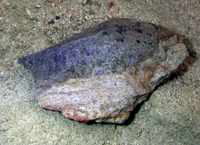
Multicoloured core.
Photo: Don Hitchcock 2005
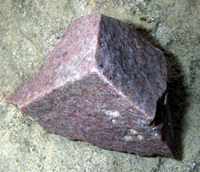
Tetragon shaped tool, or part of one.
Photo: Don Hitchcock 2005
The quarry - the western side of the lake, where there is an outcrop of silcrete pebbles
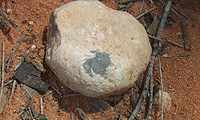
Silcrete pebble such as would have been used to make the tools.
Photo: Don Hitchcock 2005
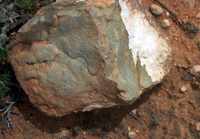
Large silcrete pebble.
Photo: Don Hitchcock 2005
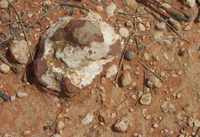
Large silcrete pebble.
Photo: Don Hitchcock 2005
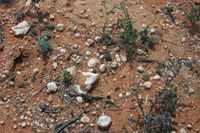
Field of silcrete pebbles.
Photo: Don Hitchcock 2005
This photo shows a coolamon, or container, with a grinding stone. The coolamon contains seeds in this display.
The muller referred to on the label is the upper, hand-held grindstone, out of frame in this photo.
In the semi-arid to arid regions of Australia, seed-foods were a major food staple. First Nations women made flour from a range of different plant seeds, including those of native grasses, some trees, shrubs, succulents and even ferns. The flour made from these seeds was an extremely nutritious high-energy food that was of vital importance in regions where other more easily processed plant foods were not readily available.
First Nations women developed an intricate method of processing the seeds they gathered. Collected material was placed in a coolamon (elongated wooden dish) and skilfully rocked and flicked to separate material of different densities (such as leaves, twigs and sand) so the seeds were easily extracted. Seeds were then winnowed by being rubbed together in handfuls and dropped a short height over the coolamon to allow the fine outer husks to blow away. The seeds were then ground into a meal or flour using a millstone (lower grindstone) and muller (hand-held upper stone) set.
Text: From the Australian Museum website,
http://www.amonline.net.au/snapshots/arid/bakers.htm
Display: Lake Mungo NPWS interpretation centre
Photo: Don Hitchcock 2005
References
- Allen H., 1998. Reinterpreting the 1969-1972 Willandra Lakes archaeological surveys, Archaeology in Oceania 33:207 - 220.
- Barbetti M., McElhinny M., 1976. Philosophical Transactions of the Royal Society of London. Series A, Mathematical and Physical Sciences, Vol. 281, No. 1305 (May 20, 1976), pp. 515-542
- Barbetti M., Polach H., 1973: ANU radiocarbon datelist V. Radiocarbon 15(2):241–51.
- Connolly M., 1985: Petrography and classification of silcrete, Definition and occurrence, rune.une.edu.au, University of New England.
- Cottrel & Kamminga, , 1987: The formation of flakes, American Antiquity 52(4) DOI: 10.2307/281378
- Dixon J., 2022: The formation of flakes, Weathering and Soil Processes, in: Treatise on Geomorphology, Second Edition, 2022.
- Doelman, T. et al., 2001: Source to discard: patterns of lithic raw material procurement and use in Sturt National Park, northwestern New South Wales, Archaeology in Oceania, 36, 15–33.
- Douglass J. et al., 2017: The nature of silcrete adzes in the formation of Australian stone artefact assemblages, Journal of Archaeological Science: Reports, Volume 15, 2017, Pages 578-586, ISSN 2352-409X, doi.org/10.1016/j.jasrep.2017.04.013.
- Bowler J. et al.., 1970: Pleistocene Human remains from Australia: a living site and human cremation from Lake Mungo, western NSW, World Archaeology 2:39-60
- Gillespie R., 2002: Dating the first Australians, Radiocarbon, Vol 44, Nr 2, 2002, p 455 - 472
- Hiscock P., 1993: Bondian technology in the Hunter Valley, NSW, Archaeology in Oceania, 28(2):64-75
- Hiscock P., Allen H., 2000: Assemblage variability in the Willandra Lakes, Archaeology in Oceania, 35: 97-103
- Lenher V., Merril H., 1917: The solubility of silica, J. Am. Chem. Soc., 1917, 39, 12, 2630–2638, doi.org/10.1021/ja02257a013
- Morey G. et al., 1962: The solubility of quartz in water in the temperature interval from 25° to 300° C, Geochimica et Cosmochimica Acta, 1962, pp. 1029-1040, IN11, 1041-1043
- Muhlen-Schulte, R., 1985: Mungo rocks. A technological analysis of stone assemblages from Lake Mungo. , Unpublished BA honours thesis, ANU.
- Schmidt, P., Hiscock P., 2020: The antiquity of Australian silcrete heat treatment: Lake Mungo and the Willandra Lakes Journal of Human Evolution, Volume 142, May 2020, 102744
- Stern, N., 2020: Lake Mungo, Archaeology of. In: Smith, C. (eds)Encyclopedia of Global Archaeology, Springer, Cham. https://doi.org/10.1007/978-3-030-30018-0_699
- Stern, N. et al., 2013: Strategies for investigating human responses to changes in landscape and Climate at Lake Mungo in the Willandra Lakes, Southeast Australia In: Frankel et al. (eds), Archaeology in Environment and Technology, Routledge, NY
- Summerfield, M., 1983: Silcrete, in: A.S. Goudie and K. Pye. (eds),Chemical sediments and geomorphology, San Diego: Academic Press, pp. 59-92.
- Webb, J., Domanski, M., 2008: The relationship between lithology, flaking properties and artefact manufacture for Australian silcrete, Archaeometry,50: pp. 555-575
- White, J., O'Connell, J., 1982: A Prehistory of Australia New Guinea and Sahul, Stock No. 208638
- Williams D., 1991: The case of the shattered stones, BA Honours thesis, ANU Canberra
